July 25 - 31, 2021: Issue 503
Mona Vale Cemetery: Some History
For those with a passion for history local churches and cemeteries are a place always visited as there you may see and wonder about those who stood here before you. These sacred grounds, usually quiet, are one of the few places you may find a tribute and marker for someone who has been brought to life through research and many a historian will include a visit to their gravesite as part of the work done. For those who do go that extra mile, that place provides a time to give thanks for what that person has contributed to all and to marvel over the sometimes long and wending road they have taken through their life.
Such was part of the investigation for Harold Tristram Squire, Artist, in 2020. Being able to stand where he was interred and marvel at his road and offer thanks for the few remnants of his work we still have in Mona Vale and Bayview in the Bayview Golf Course elephants brings a sense of current times connecting with past times.
His wife, Mabel Eunice Squire passed away on the 27th of March 1957, aged 92, and was buried with her husband on March 29th. Despite his work at making 'plaques' no headstone or plaque marks their final resting place in Mona Vale Cemetery at present - any that was there has gone. Their graves are in the old section of the cemetery 'COE-A-000' (Church of England), marked by driven into the ground yellow pegs where council has identified remains of them, and others:
The word ‘cemetery’ comes from the Greek word for ‘dormitory’ or ‘sleeping chamber’ although it did not become a common word in our English language until the 1800s. Then death was thought of as a temporary state like sleep as one passed from death to eternal life. Burial occurred in the crypts or in the graveyards of churches, as well as around large family estates. In the late eighteenth and throughout the nineteenth century this practice was gradually discontinued. The reasons for this would include the sharp rise in population in the early stages of the industrial revolution, and lack of space and poor conditions in existing graveyards, which were often within city walls. There was also resistance within the church to burying those who did not attend, even though there was a legal requirement to bury a resident of the parish. As a result, governments, local authorities and religious groups all changed their regulations for burials.
New places of burial were established outside of towns and away from densely populated areas. The location of cemeteries away from arable land and water supply catchments was also an important consideration. Use of manual labour made it desirable to have adequate drainage with soil of a depth and character that allowed graves to be dug easily. The new cemeteries were run by local municipal authorities or trusts and were independent from churches, although they were generally still segregated by the faith of the deceased to be buried there. Graves were orientated towards the east in preparation for Doomsday and the second coming of Christ, as this was the direction from which Christ was expected to appear. This east/west arrangement of graves is the most common orientation in other parts of the world as well.
The Victorian era saw the establishment of 'garden cemeteries' in which not only the dead rested, but the living communed with each other and with nature. These were destinations in their own right, where the public could stroll along walkways, carriage paths and bridges, meeting with friends and family in their leisure time. Some cemeteries even doubled as botanical gardens, with trees and plants labelled with their botanical names.
At the beginning of the twentieth century there was a move away from these elaborately landscaped garden cemeteries back to a more utilitarian style. The grid arrangement was revived, with less attention paid to landscaping or gardens. Trees were removed as new burial sites were required and were even thought to be a nuisance in that they interfered with excavations and uprooted cemetery monuments over time.
The earliest burials in the Pittwater area occurred close to the locations in which the deceased were found. Many seamen were buried along the western foreshores where they were found washed up after shipwrecks. Those who lived here often interred loved ones on the properties themselves. Later the local people were buried in the graveyards of the local churches, such as St Johns Anglican Church or the graveyard at Church Point (or Chapel Point as it was then known).
In November 1891 the original 'General Cemetery' of ten acres was detailed on the plan for the new 'Village of Turimetta'. It was next to a 'Recreation Ground' (what is now Kitchener Park) and the “Black Swamp” (now part of Mona Vale Golf Course) and was located on the corner of Bilgola and Mona Streets (now Barrenjoey Road and Golf Avenue and formerly Beeby Park) with sections allocated for Roman Catholic, Presbyterian, Wesleyan, Jewish, Independent, Church of England and a “General” section. Trustees were appointed for these different sections from among the residents.
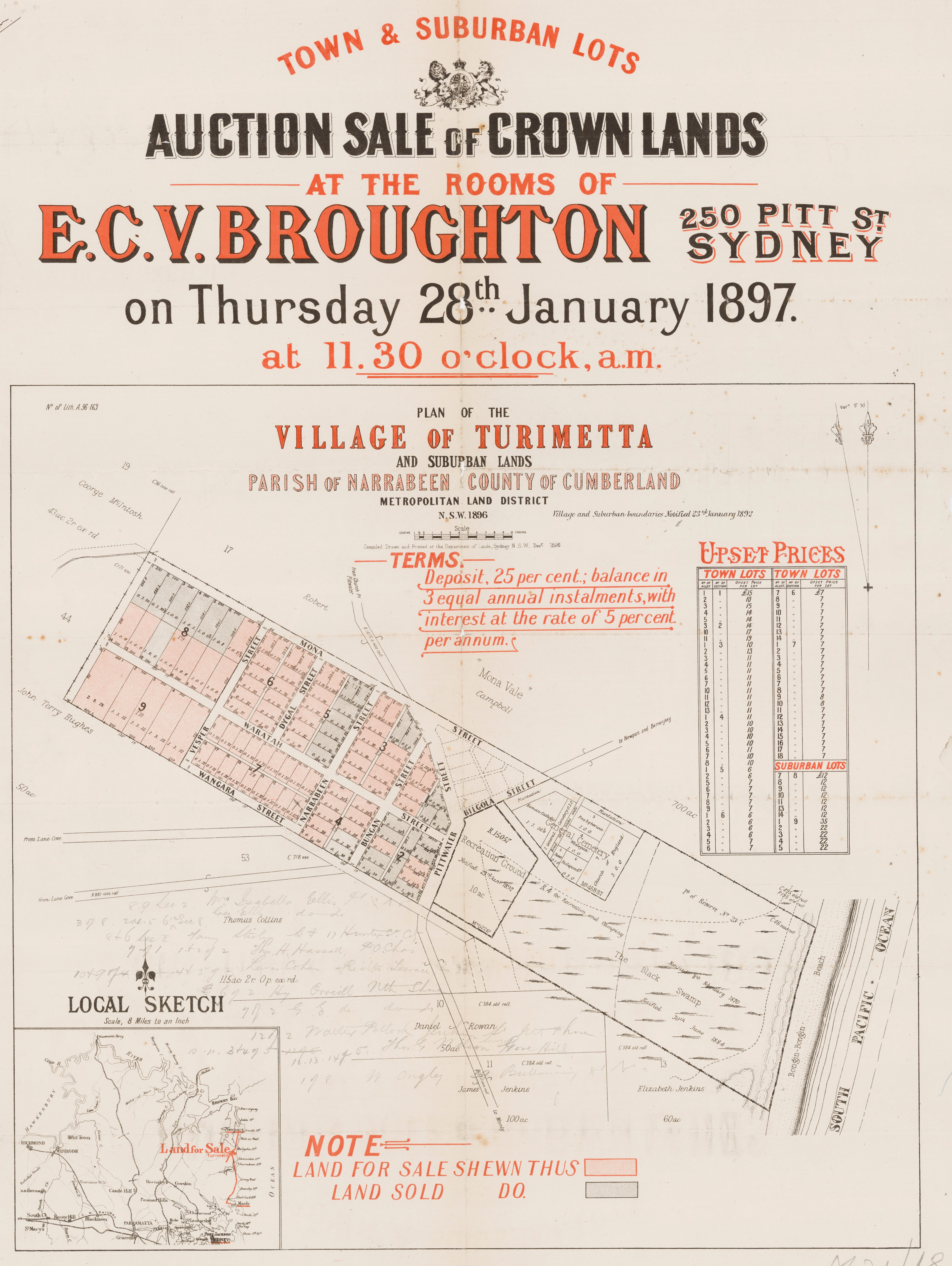
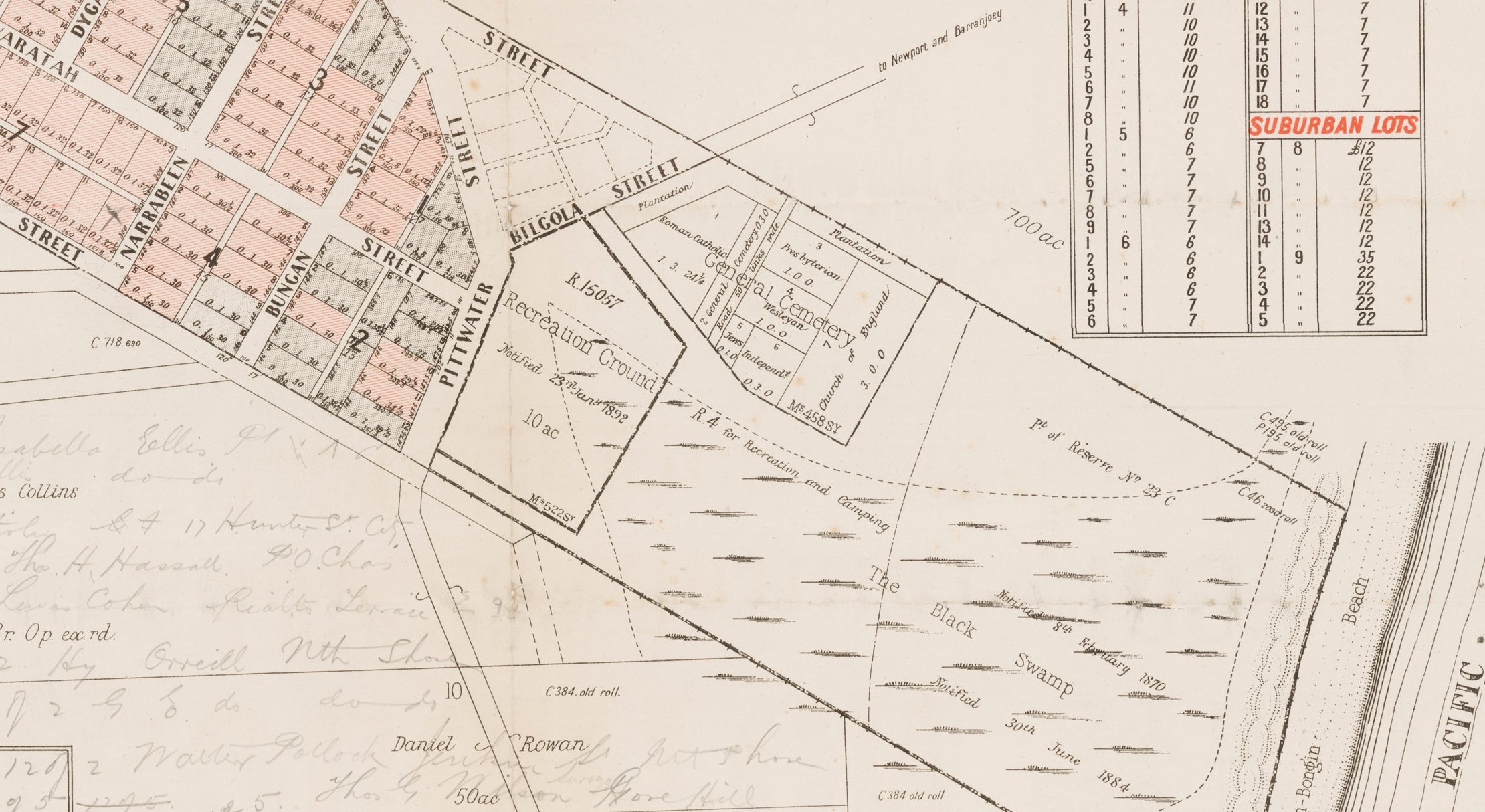
Plan of the Village of Turimetta and Suburban Lands - Parish of Narrabeen - Vesper St, Mona Street, Allen St, Pittwater St, Wangara St, 1897 “Village of Turimetta” with cemetery. Note the site of the farm known as “Mona Vale”, a name given to this place by early resident David Foley according to family records. Item c046820016, from Pittwater Subdivision records, courtesy State Library of NSW
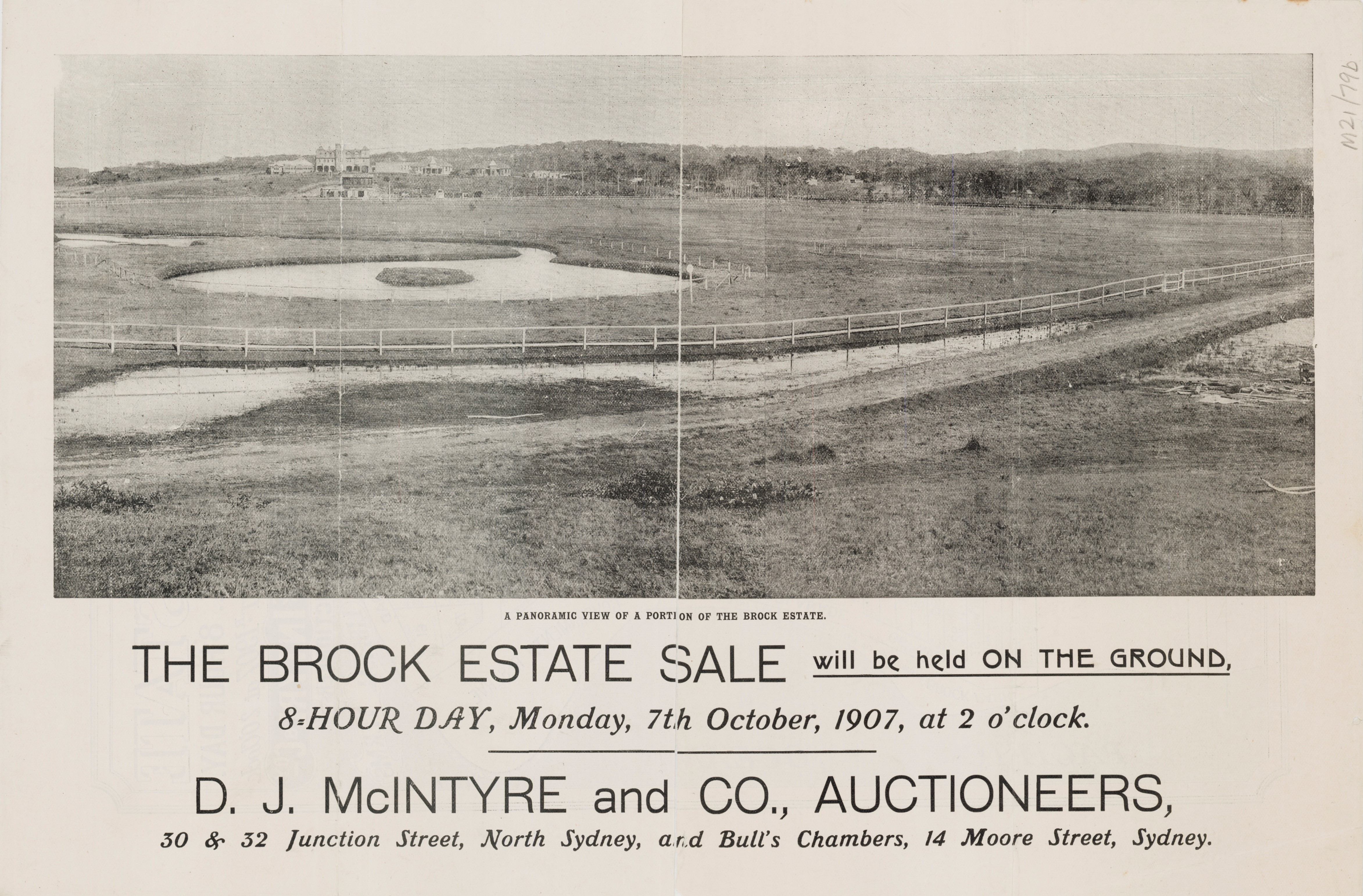
The Brock Estate - 1907, inner page brochure, Item No.: c046820077, Mona Vale Subdivisions, Courtesy State Library of NSW. View looking towards Brocks Mansions across polo grounds and 9 hole golf course and the ”Black Swamp”. The original Turimetta cemetery would have been located to the left of the building in the picture.
Department of Lands,
Sydney, 12th June, 1901.
IT is hereby notified, for public information, that in accordance with the provisions of the 100th section of the Crown Lands Act of 1884, His Excellency the Lieutenant-Governor,
with the advice of the Executive Council, has been pleased to approve of the appointment of the undermentioned gentlemen as Trustees respectively of the portions of land hereinafter particularised, namely:—
The portion of the General Cemetery at Turrimetta, parish of Narrabeen, dedicated 11th November, 1891, set apart for Unsectarian Burial Ground :—
Messrs. Henry Boulton.
Joseph Baker.
Stuart Greig.
Henry Ball.
James Joseph Roche.
James Symonds.
[Ms. 1901-3,772 Ind.] Government Gazette Appointments and Employment (1901, June 12). Government Gazette of the State of New South Wales (Sydney, NSW : 1901 - 2001), p. 4597. Retrieved from http://nla.gov.au/nla.news-article226379480
Department of Lands,
Sydney, 2nd November, 1901.
IT if hereby notified, for public information, that in accordance with the provisions of the 106th section of the Crown Lands Act of 1884, His Excellency the Lieutenant-Governor,
with the advice of the Executive Council, has been pleased to approve of the appointment of the undermentioned gentlemen as Trustees respectively of the portions of land hereinafter
particularised, namely :—
The portion of the General Cemetery at Turrimetta (Narrabeen), dedicated 11th November, 1891, set apart for Presbyterian Burial Ground :—
Messrs. John Woods,
Frederick Trenchard Smith,
Alexander Ralston,
Hector Campbell, together with the Moderator and the Clerk of the Presbyterian General Assembly and the Minister of the congregation for the time being.
[Ms. 1901-8,025 Ind.]
The portion of the General Cemetery at Turrimetta (Narrabeen), dedicated 11th November, 1891, set apart for Wesleyan Burial Ground :—
The Reverend Thomas Frederick Potts.
Messrs. Samuel Morrison.
James Symonds.
Edward Edget Baylis.
Richard John Wild.
[Ms. 1901 8,025 Ind ] W. P. CRICK. Government Gazette Appointments and Employment (1901, November 2). Government Gazette of the State of New South Wales (Sydney, NSW : 1901 - 2001), p. 8508. Retrieved from http://nla.gov.au/nla.news-article226389205
This site was never used as a cemetery. By 1904 negotiations to purchase an alternative site for the cemetery along 'Lane Cove Road' were underway. Perhaps the proximity to the “Recreation Ground” as well as the “Black Swamp” itself, were factors in this decision. The construction of Brock’s Mansion and cottages (commencing 1894) virtually across the road from the planned cemetery may also have had some influence on the decision to relocate.
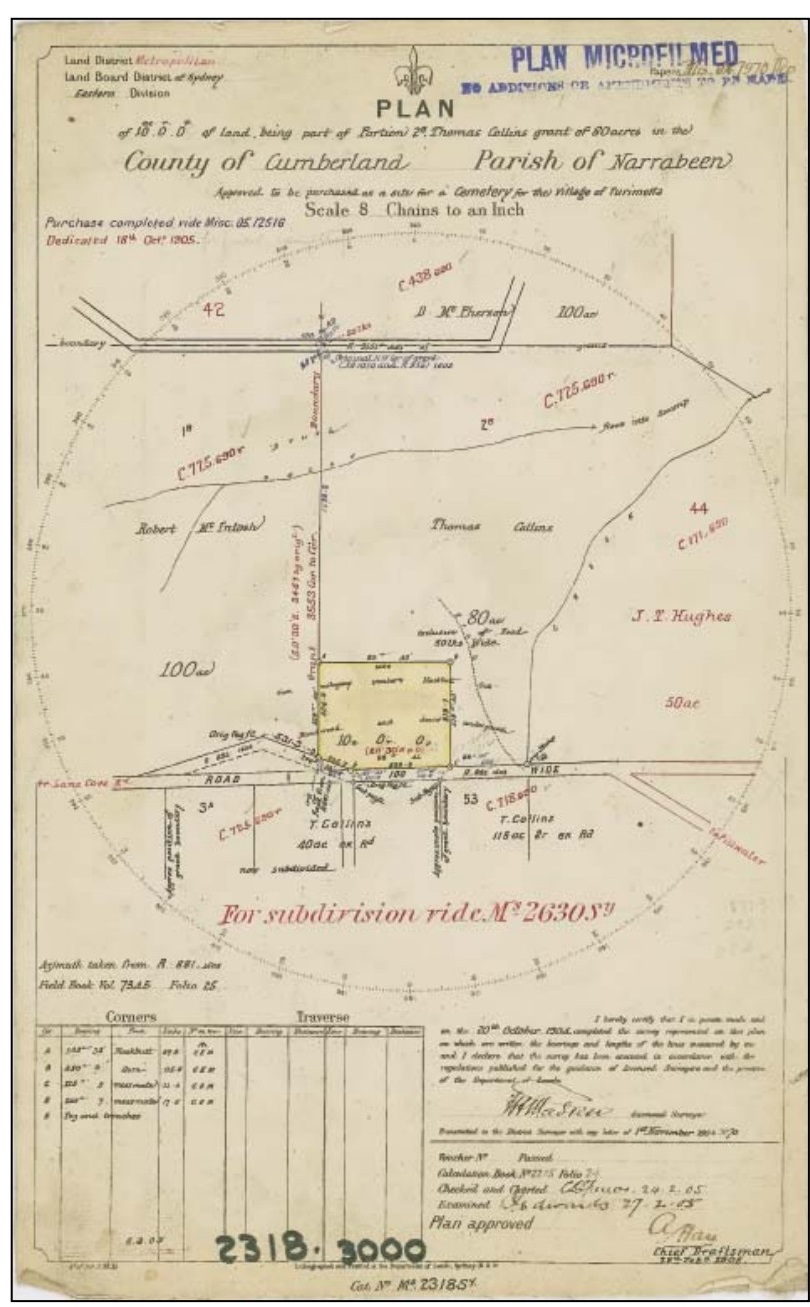
Plan of land approved to be purchased as a site for a 'cemetery' for the Village of Turimetta 27th February, 1905
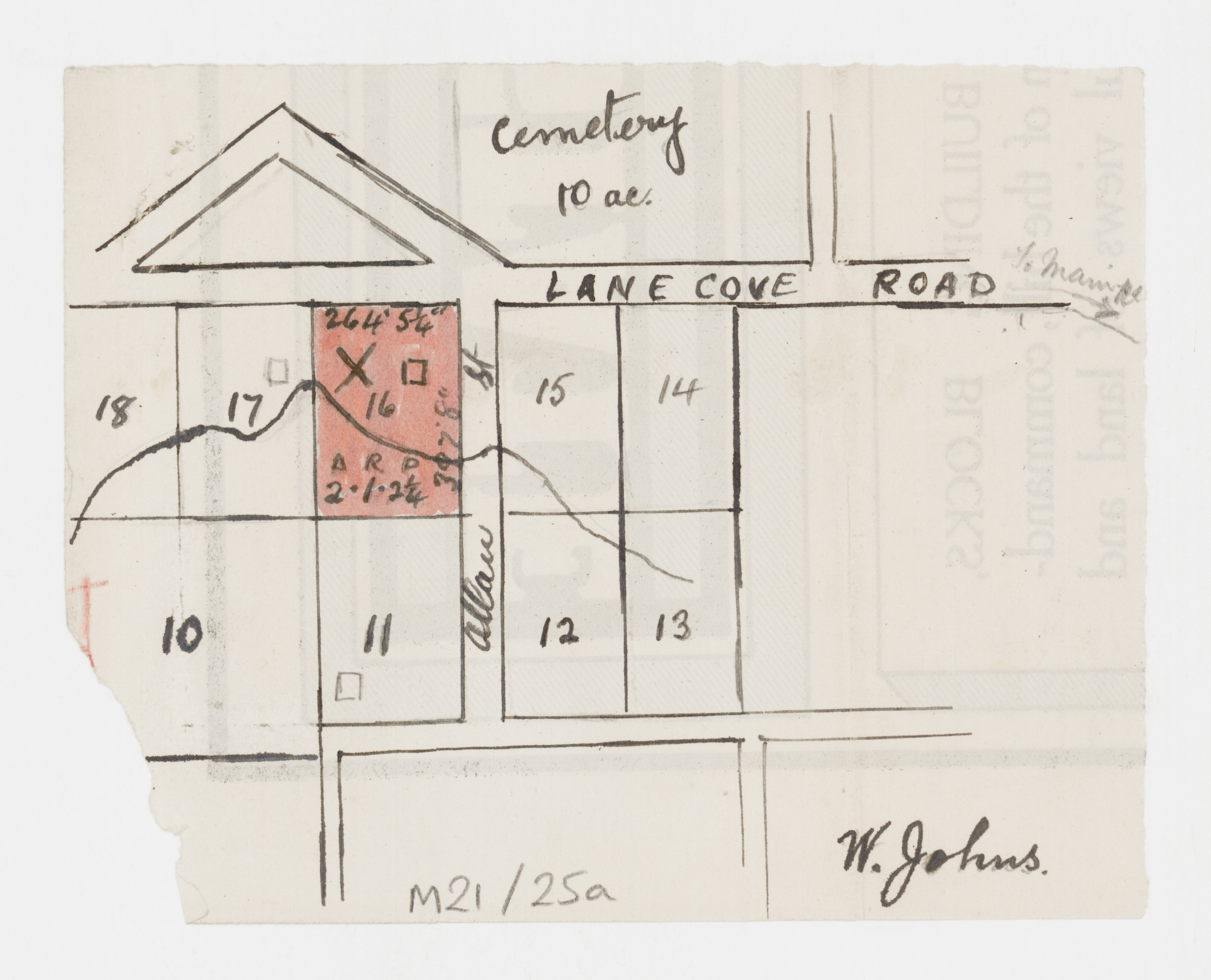
Sketch plan of Mona Vale - [Cemetery] - Lane Cove Rd Item c046820023, Mona Vale Subdivisions, Courtesy State Library of NSW
On the 17th of October 1905, a new site consisting of ten acres of land along Lane Cove Road was dedicated for use as a 'General Cemetery' in the Government Gazette.
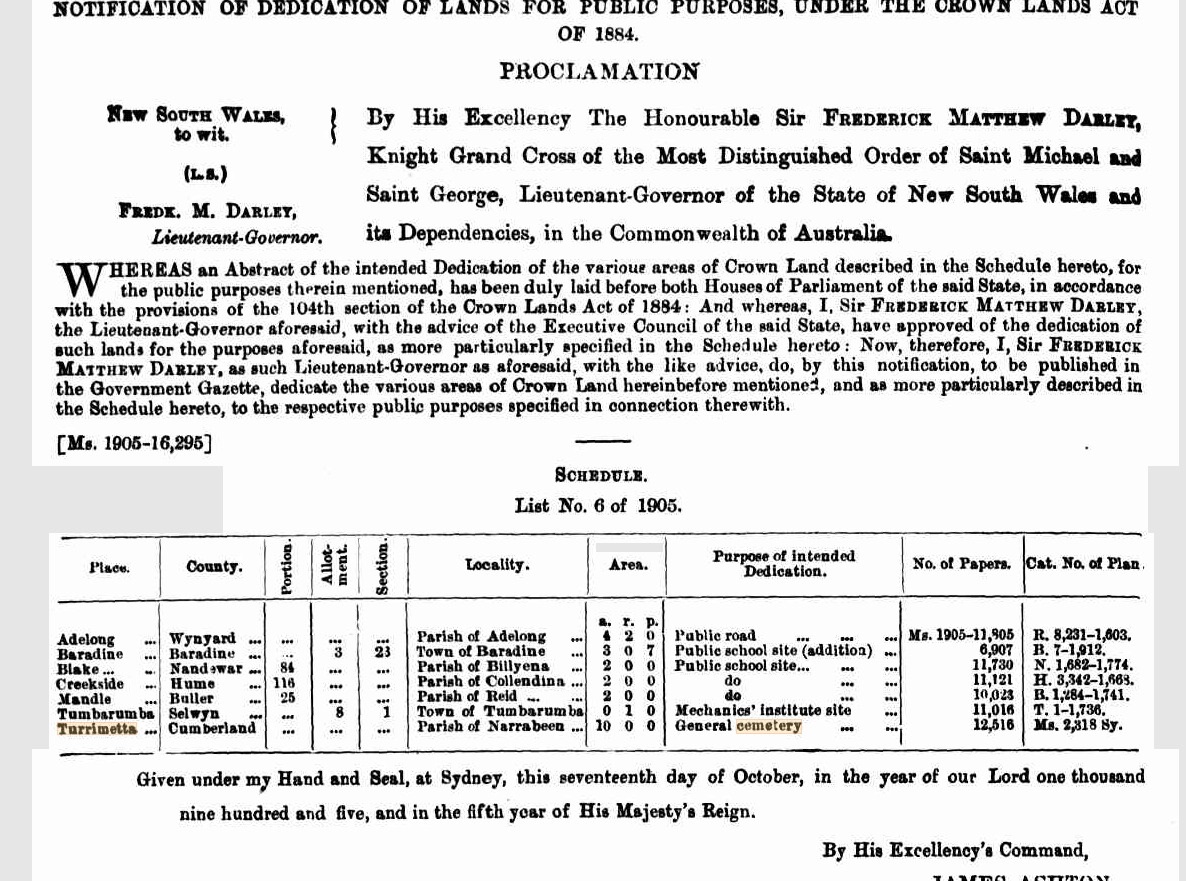
NOTIFICATION OF DEDICATION OF LANDS FOR PUBLIC PURPOSES, UNDER THE CROWN LANDS ACT OF 1884. (1905, October 18). Government Gazette of the State of New South Wales (Sydney, NSW : 1901 - 2001), p. 6998. Retrieved from http://nla.gov.au/nla.news-article220951984
The land was part of an 80 acre grant to notorious local farmer Thomas Collins, although by then he had onsold it and it eventually became part of a Halloran subdivision. Some of the Collins land had already been subdivided, including the 'Collingwood Estate' which began selling in 1886. This subdivision included the block upon which the “Rock Lily” Hotel was built. The subsequent subdivision of the “Rocklily Estate” in 1905 clearly shows the cemetery in the new location on Lane Cove Road. During this period the Warringah Shire area had a population of around 2800, with 700 dwellings.
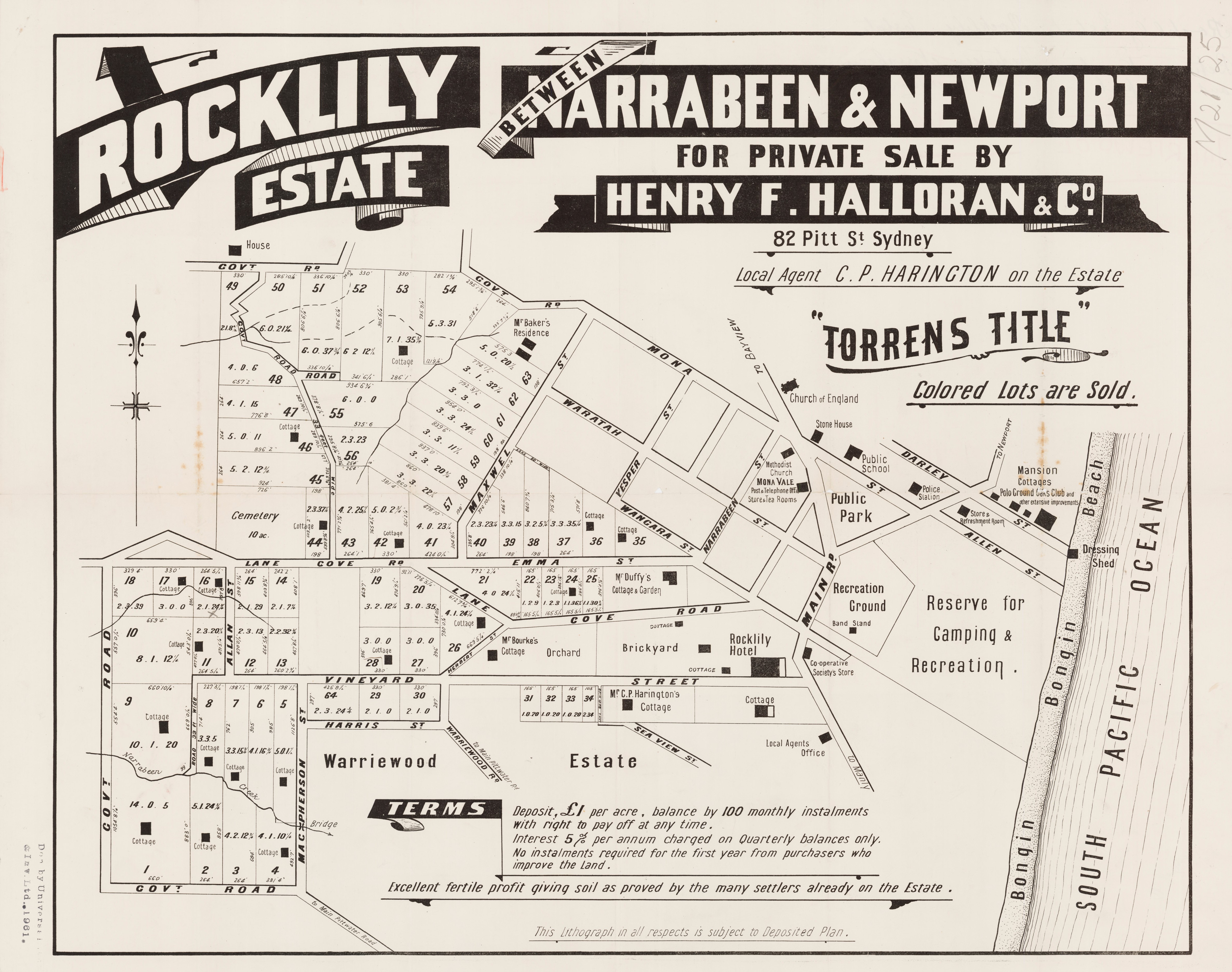
Rocklily Estate between Narrabeen & Newport - Macpherson St, Item c046820022
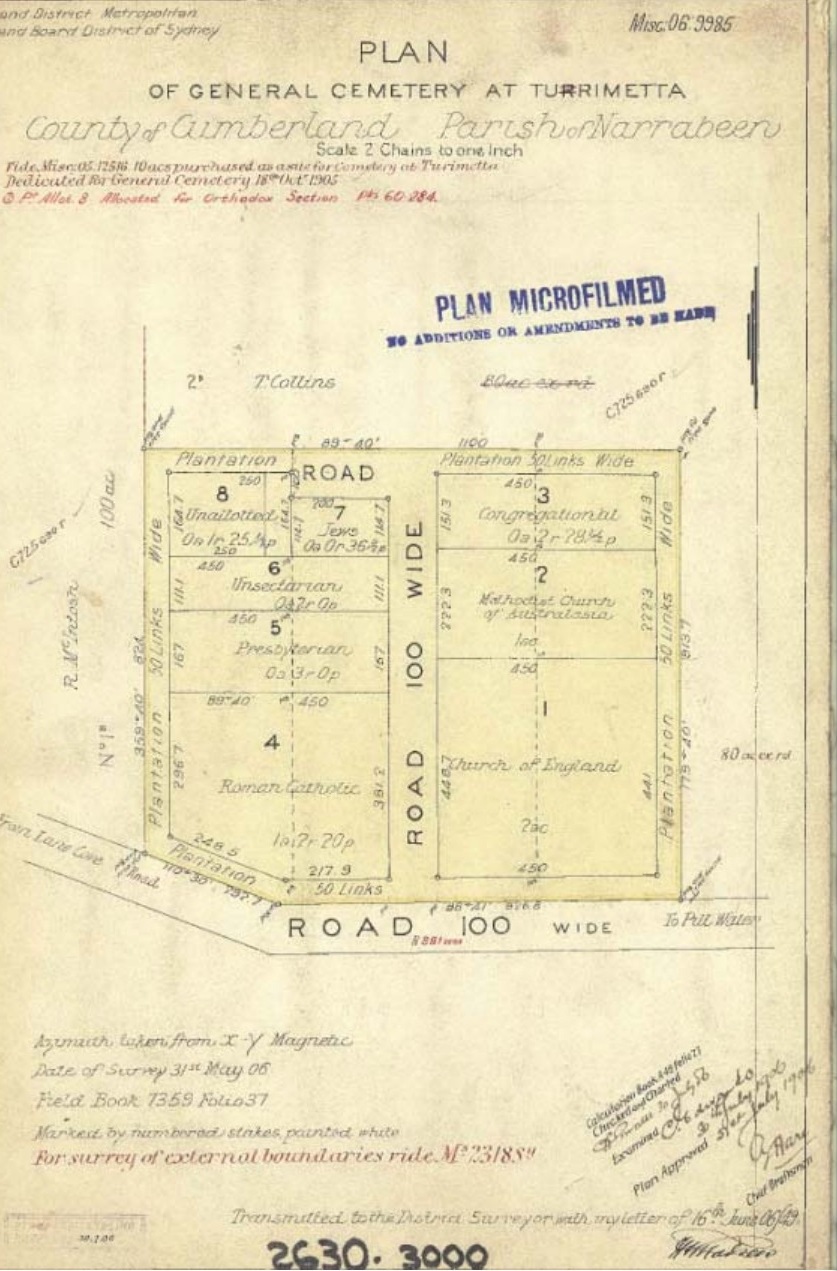
The plan for the cemetery in the new location on Lane Cove Road dated May 31st 1906 depicts eight sections for Church of England, Methodist, Congregational, Roman Catholic, Presbyterian, Unsectarian and Jewish burials, with one section unallocated.
Once again Trustees were appointed from among the residents:
Department of Lands,
Sydney, 10th October, 1906.
IT is hereby notified, for public information, that, in accordance with the provisions of the 100th section of the Crown Lands Act of 1884, His Excellency the Governor, with the advice of the Executive Council, has been pleased to approve of the appointment of the undermentioned gentlemen as Trustees respectively of the portions of land hereinafter particularised, namely:—
The portion of the General Cemetery at Turrimetta, dedicated 18th October, 1905, set apart for Unsectarian Burial Ground:—
Messrs. George Powell.
Isaac Larkin.
James Seggi Russell.
George Byles.
Albert Heaton.
. [Ms. 1906-17,093] Government Gazette Appointments and Employment (1906, October 10). Government Gazette of the State of New South Wales (Sydney, NSW : 1901 - 2001), p. 5624. Retrieved from http://nla.gov.au/nla.news-article226529029
The Trustees appointed in 1906 for the Church of England portion were John Blackwood, Cornwallis Wade Browne, Samuel Stringer, Stuart Greig and William Boulton.
In those days people would apply to the local police station for permission to bury their dead, and then undertake the burial, including digging the grave, themselves. This probably explains the seemingly haphazard manner in which the early graves are arranged (see Figure 2.8, 2.10 and 2.11). The earliest burials were in the Church of England and Methodist sections.
The oldest surviving headstone in the cemetery is for Percy Johnson who died in 1914 aged just two years and 9 months.
NSW BDM's: JOHNSON PERCIVAL W 4549/1914 parents: WILLIAM S LUCY registered at: MANLY
Percival was the great-grandson of William Oliver, who donated part of his land at what was then Chapel Point (now Church Point) for a cemetery and place of worship for the local community. His great grandfather and grandmother rest in this cemetery at Church Point.
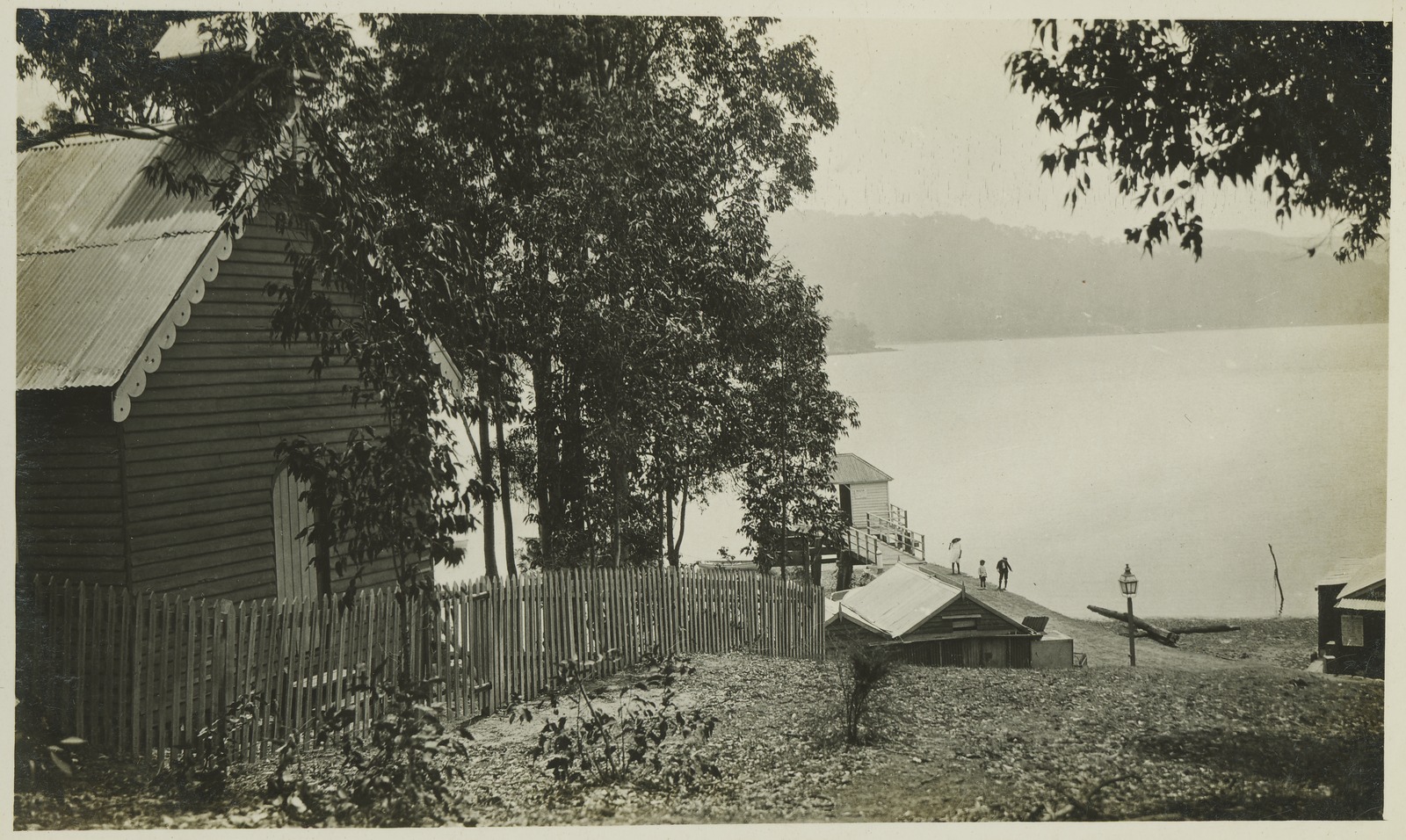
Percy’s memorial is the oldest marked monument in the cemetery and is an example of Victorian grave architecture, with iron railings decorated with fleurs-de-lis uprights and round florette spears on the corners. The headstone is of marble with lead inscription work in good condition. This monument was restored by the Rookwood Cemetery Heritage Mason, Sach Killam, funded by Percy’s niece in 2013. Percy is buried with his maternal grandmother, Mary Bill, while his paternal grandmother, Louisa Johnson, (daughter of William Oliver) is buried beside him.
The Department of Lands was originally responsible for the cemetery but by 1926 the cemetery was neglected and local people, particularly the Mona Vale and District Progress Association, were urging Warringah Shire Council to take over its management which occurred from May 31st 1929, although the Catholic Church retained control of their portion of the cemetery until 3 August 1984.
The Council Trusteeship of the remainder of the cemetery was revoked and another Board appointed until October 16th 1956 when Council was reappointed, excluding the Roman Catholic section.
NOTICE APPOINTING A TRUSTEE UNDER THE PUBLIC TRUSTS ACT, 1897.—PROCLAMATION.
IN accordance with the provisions of the Public Trusts Act, 1897, I, Sir Kenneth Whistler Street, Lieutenant-Governor of the State of New South Wales, with the advice of the Executive Council, do, by this notice, appoint The Council of the Shire of Warringah as Trustee of the Turrimetta General Cemetery (excluding Roman Catholic portion), parish of Narrabeen, county of Cumberland, dedicated 18th October, 1905, in the place of F. W. Bohm, L. B. Wigney, W. J. Hodge, N. G. Stanton, F. E. Whittaker and E. W. Harvey, removed. P. 56-3,771.
Signed and sealed at Sydney, this 16th day of October, 1956.
K. W. STREET, Lieutenant-Governor. , By His Excellency's Command,
ROGER NOTT, Minister for Lands. (779) GOD SAVE THE QUEEN! NOTICE APPOINTING A TRUSTEE UNDER THE PUBLIC TRUSTS ACT, 1897.—PROCLAMATION. (1956, October 19). Government Gazette of the State of New South Wales (Sydney, NSW : 1901 - 2001), p. 3046. Retrieved from http://nla.gov.au/nla.news-article220346575
The pair of sandstone gate posts marking the original entrance to the cemetery on the edge of Mona Vale Road were constructed in 1929 by local stonemason James Booth, who was also a Church Point storekeeper and boat builder. Mr Booth was associated with the construction of a number of other important local structures in the area, including the house 'Dungarvon' on Park Street, the first Mona Vale Public School and St. John's Church of England (circa 1906-1907) on Pittwater Road, Mona Vale. James Booth (1862-1941) was interred in Walton NSW but there is a plaque for him on a family grave at the cemetery.
Warringah Shire Council records provide:
Jas. Booth. 31/10/29. Submitting proposal for improvement of gate entrance to Mona Vale Cemetery, and offering to do the work for £14. Referred to the Engineer for report.
Jas. Booth. 8.1.30. Claiming that the gates erected by him at Mona Vale cemetery are not insubstantial, as reported. 21a. Same. 23.1.30. Submitting proposal for improving and strengthening the gate entrance at the cemetery, which work he is prepared to carry out for £14. Referred to the Works Committee for report.
The condition of the gate posts is deteriorating and they are no longer as prominent as they once were, as their location is now separated from the cemetery proper by a landscaped mound. The white paint on the posts is flaking a and a redundant galvanised gate is attached to one of the posts.
In the original plan of the cemetery there were “Plantations” of 50 links wide (approximately ten metres) noted on all four borders of the site, although the type of plants were not noted. The original survey of the site notes 'Gum, mahogany, ironbark, blackbutt, oak, bloodwood and dense undergrowth on the site'. Today all of the borders of the cemetery retain some kind of landscaping. Along the eastern and western boundaries there are native tree species such as Weeping Lilly Pilly or Swamp Oak while the southern boundary has a variety of native trees and shrubs. There are also a number of trees planted along the new fence on the northern boundary of the cemetery.
Also in the original plan was a 100 links wide (approximately twenty metres) road running through the centre of the cemetery travelling north from the original entrance. This entrance was marked by a pair of sandstone gate posts (on what is now Mona Vale Road). This road separated the Catholic and Anglican areas of the cemetery as religious persuasion was quite an issue in society at that time. Anecdotal reports state that in the early 1960’s a new vehicle access road was created to the east of this original central road (probably at the same time as the amenities block was constructed) and the original roadway was closed to vehicles.
The present avenue of cypress pines that runs along the former road was planted some time in the 1970’s and there was also a red gravel pathway running between the trees. Evergreen pine trees and conifers were symbols of immortality and the after-life and were popular in Victorian era cemeteries. It is not known whether they were chosen for that reason. In 1996, in response to the shortage of land available, Council began using this area between the trees for burial sites. The entire two rows were sold. An aerial view of the cemetery in shows the existing avenue of Cypress trees planted along what is now Anglican Section W.
The cemetery is a monumental cemetery with a variety of styles of memorialisation reflecting the changing tastes of the community over the past 110 years. They range from the simple wooden cross to the more conventional sandstone headstone and to elaborate granite monuments with thick slabs. The oldest monuments are located in the Methodist and Anglican sections. It is important to note that burial monuments are the property of the burial licence holders, and not the cemetery Trust.
The cemetery has three historical areas with monuments dating back to the early 1900s with some marked simply with a large rock. The oldest sections are located in the Methodist Section A and B, the Anglican Section A and the Non-Sectarian Section O.
At present, the granting of the burial licence is on a perpetual basis, so a person could come forward and make an application for the transfer of the licence for an old grave. Generally the licence must be ceded by a Will or Letters of Administration for the application to be successful.
Over the years the way that cemetery information has been recorded has changed. No surviving records for the earliest graves have been found but old registers do exist from the 1930’s. Later on information was recorded on a card system and then on computer in various systems until our present-day electronic file management system. There are other items including maps, plans, copies of title deeds and other published material that are in themselves items of heritage value. The old registers have been copied and are stored on disc and microfiche.
There have been a number of checks and reviews of the cemetery database in recent times. A survey of unmarked burial sites occurred in 1989 and 34 possible unknown burial sites were identified. A more recent survey of monuments revealed a number of unrecorded inscriptions. These have been added to cemetery records. The Manly Warringah and Pittwater Historical Society also carried out a transcription of the cemetery some years ago and their findings were cross referenced with cemetery records at that time.
Older cemetery records are incomplete, as many of the addresses noted have no street number (in those days there may have been only a few houses in the street). Some of the personal information now collected for every interment, such as date of death and age at death, was not recorded in those days. Spelling errors have been detected caused by the difficulty in deciphering hand writing in the old registers. In recent years, Pittwater Council had been collecting and recording details of additional inscriptions in the cemetery register as well as correcting spelling errors when they are identified.
The cemetery itself, as well as the original sandstone gate posts were added to the schedule of Heritage Items in the Pittwater Local Environmental Plan in June 2009, when 'Amendment No 81 - Heritage Conservation' was published on the NSW Government Legislation website. The listing as it appears in Schedule 9 - Heritage Inventory is reproduced below. Note that the cemetery has also been assessed by the National Trust, but has not been listed. Location Description DB No. Mona Vale Road, No 107 Land Nos 2630–3000 Mona Vale (formerly Turimetta) General Cemetery, including stone gateposts DB No.s; 2270088 and 2270327
The last fifty years at the cemetery has seen the expansion of burials towards the four boundaries of the site and the introduction of areas for the disposition of ash remains, including the wall columbarium (built in the 70’s) and a number of memorial garden areas. The original grid-style, east-west orientation of burial sites has been retained while the memorial gardens have been positioned in areas where in-ground burials are impractical, such as under stands of trees on the eastern side.
The Columbarium (wall niche) for the placement of cremated ash remains was opened in 1974 and named “S.O Reynolds Memorial Wall” in memory of Warringah Councillor Sydney Owen Reynolds (Councillor from 1956 to 1959). His request for the provision of interment facilities for ash remains in the area led to the proposal for the wall to be erected. Both the wall and memorial gardens are non-denominational.
The cemetery layout provides sections for a number of religious denominations. The original plan designated areas for the Roman Catholic, Church of England, Methodist Church of Australasia, Presbyterian, Congregational, Unitarian and Jewish faiths as well as an “unallocated” area reflected the predominant religions in society at that time.
In later years, areas for the Uniting Church, Bahai and the Latter Day Saints faiths were slotted into existing areas. There appears to have been only one Jewish burial in the section devoted to that religion (in 1974) and this area was later turned into Non-Sectarian Section N.
Despite the rising cremation rate, some religions such as Baha'i and Serbian Orthodox still forbid cremation, while the Catholic Church allows it but requires that ashes are treated with the same respect that would be accorded a burial and are placed in a suitable location. The Baha'i burial practices require that the deceased is not carried more than one hours journey from the place of death. For these reasons the ongoing provision of in-ground burial sites will continue to be important to particular religious groups in the local area.
Council does not rigidly enforce the religious segregation at the cemetery and people are able to choose where they wish to be interred. Members of other local religious groups such as the Serbian Orthodox are well represented throughout the cemetery.
The cemetery is open 365 days per year and enjoys a steady stream of visitors, averaging between twenty to thirty per day and increasing to an average of fifty on funeral days. The largest funerals can attract over 400 mourners. The highest visitation occurs around Christmas, Easter, Mother’s Day and Father’s Day. Some religious faiths visit the cemetery after a certain number of days and weeks have elapsed following death, and these traditions endure at the cemetery. The Catholic Church also observes All Souls Day in November each year with an on-site mass.
The cemetery had almost 6400 burial sites in the present grid layout and was at 95% capacity with fewer than 460 in-ground burial sites for immediate need or reservation in 2013. Each burial site can accommodate two in-ground adult coffin interments – i.e. one on top of the other (and also an additional child burial) plus up to four containers of cremation ashes.
It is important to note that the purchaser of a site does not actually own the land in which a burial occurs, but rather a “licence” to use this land. Currently these burial licences are sold on a perpetual tenure basis (as opposed to limited tenure which restricts the term to a pre-determined time period). The size of the site is 2.44m long x 1.065m wide or eight foot by three foot six inches on the imperial scale.
Holders of burial licences are also permitted to erect a monument on the site of a size and style that conforms to the Cemetery Regulations and complies with the current Australian Standard for Headstones and Cemetery Monuments. The maintenance of any monumental work is the responsibility of the licence holder and not the Reserve Trust.
The cremation rate in metropolitan areas was approaching 70% in 2013 when Pittwater Council published their POM for the Mona Vale Cemetery and there remains a growing demand for the placement of cremated ash remains within either existing burial sites, the available garden niche areas or in the columbarium wall. Pittwater’s natural environment has become a competitor for the cemetery as many people now choose to keep ash remains at home or scatter them at a local landmark, such as at the headland or the beach. This presents a new challenge to cemetery administrators.
There is a growing interest in information for genealogical research. In response to this, Pittwater Council developed a web-based search tool which will allow relatives and friends to search for those interred at the cemetery. This search function has become part of what the new council offers and is available online at: mona-vale-cemetery/deceased-search
In October 2018 the Northern Beaches Council, in association with the NSW Government’s Heritage Near Me program and the Manly Warringah and Pittwater Historical Society, announced the launch of a self-guided history tour of heritage-rich Mona Vale Cemetery. The tour can be accessed on Council’s website using a smart phone or iPad, taking participants on a two-hour stroll through this historic cemetery.
This Mona Vale Cemetery self-guided history tour was officially launched by Richard Michell, President of the Manly, Warringah and Pittwater Historical Society during a special Devonshire morning tea at the cemetery on Wednesday 17th October 2018 - followed by a guided ‘demo’ of the tour. Mayor Michael Regan said then the tour is based on the Journal of Local History (Volume 8) published by the Manly Warringah and Pittwater Historical Society in 2004 to commemorate the centenary of the cemetery.
The tour profiles almost 30 local identities including author and playwright Morris West (known for The Shoes of the Fisherman and other works), pioneer James Booth, early 20th Century photographer Euphemia Baker who was also the first Australian woman to become a Baha’i, Arthur Dawson Clark, an early President of Narrabeen RSL, and Margaret Vaile, Editor of the Sydney Morning Herald women's pages in the 1960s and Inaugural President of the Zonta Club of Northern Beaches in 1974. A number of prominent people who passed away since 2005 also feature in the tour, including the much-loved teacher, community activist, poet and Pittwater Mayor, the late Harvey Rose OAM.
Council has also produced a booklet to aid your investigations, downloadable as a PDF as 'Mona Vale Cemetery Historical Tour 1905 - 2005 (and beyond) Presented by the Manly, Warringah and Pittwater Historical Society' at: mona-vale-cemetery-historical-tour.pdf
This Mona Vale Cemetery Tour is also available as an Online Tour you can take which may inspire further investigations into the lives of these amazing people. Simply click on the markers and the information will come up. That can be accessed via: https://hwt.concordengage.com/northernbeaches/cemeteries/804f8930-7aae-432f-941b-2bc5a761b753/tours
The Council also has regular tours which may be resumed when it is possible to offer these post stay-at-home safety measures. Either way, for those who have an interest in local history, Mona Vale Cemetery provides an end point for your investigations or commencement place for your investigations.
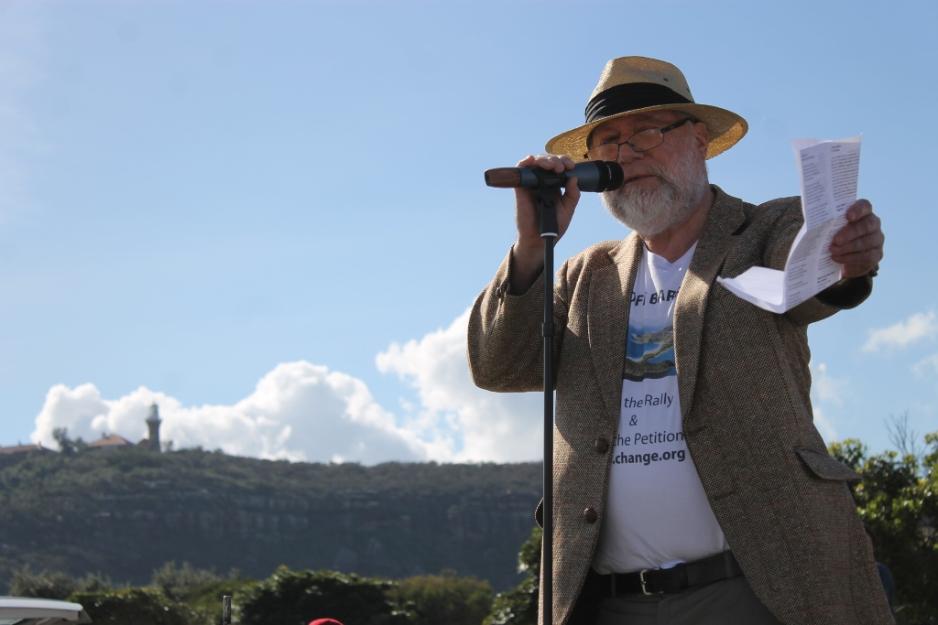
References, Notes, Extras
- Harold Tristram Squire: October 28, 1868 - May 16,1938 - Artist
- Journal of Local History Volume 7 - Bob Pauling MWPHS
- St Johns Anglican Church History on their website
- Pittwater Council Mona Vale Cemetery POM
- TROVE; National Library of Australia.
- Daniel Gordon Soutar's Influence On Local Golf Courses: Some History Notes
- Methodist Church at Church Point
- Narrabeen Cenotaph + RSL History: 100 And 65 Years Markers Of Service In 2021 - Light Up The AWM Dawns With Their Names
STATUARY STOLEN.
MONA VALE CEMETERY DESECRATED.
A flagrant act of desecration occurred at Mona Vale Cemetery within the past few days, a symbolic statue, the creation of Mr. H. Tristram Squire, having been stolen from the grave of the late Mr. Henry Moncur Atkinson.
About four months ago Mr. Atkinson, a resident of Mona Vale, died at the age of 92, and, as he was an ardent bird-lover, his niece, Mrs. O'Reilly, of Pymble, thought it would be appropriate to perpetuate his memory by a drinking vessel for the native birds with which the Mona Vale district abounds. Mr. Squire, who during recent years has specialised in statuary representing birds, animals, and aborigines, was commissioned, and a fort-night ago he placed on the grave a handsome statue of a stork, five feet high, standing over a large bowl. The latter, which was inscribed with grape leaves, was filled with water for birds to drink from.
Apparently the statuary was only in position a week when the stork disappeared. The bowl was carried a few yards, turned upside-down, and smeared with mud, the thieves apparently intending to disguise its beauty pending an opportunity to return for it. One evening at dusk a man was seen from a distance in the cemetery staggering under a heavy load, with which he drove off in a car. This was evidently the stork, which, being constructed of concrete and reinforced with iron; weighed about a hundredweight. The police, who are investigating the robbery, are puzzled as to the motive of the thieves, since the stork is signed with the sculptor's name.
Mr. Squire's work is familiar to tourists who pass along the road to Bay View and Church Point. His group of elephants is conspicuous at the Bay View golf links, and a family group of aborigines encamped about a natural pond in his grounds causes many a motoring party to stop. STATUARY STOLEN. (1935, April 10). The Sydney Morning Herald (NSW : 1842 - 1954), p. 13. Retrieved from http://nla.gov.au/nla.news-article17157874
GRAVE DESECRATED TABLET UPROOTED
A second act of desecration has occurred at the Mona Vale cemetery following the theft of a statue, the work of Mr. H. Tristram Squire, a fortnight ago.
The statue was a representation of a stork, five feet high which Mr. Squire had modelled and sculptured in cement, and erected over the grave of the late Mr. Henry Moncur Atkinson. Associated with the stork was a large drinking vessel for the native birds, of which Mr. Atkinson was an ardent protector.
After the disappearance of the stork, Mr. Squire tended the grave. He visited the cemetery again yesterday and found that the grave had been disturbed. The tablet inscribed with the name of Mr Atkinson had been torn from the ground and was upside down. The drinking bowl, a handsome engraved vessel, 15 inches in depth and two feet across, was lying on the grass. GRAVE DESECRATED. (1935, April 19).The Sydney Morning Herald (NSW : 1842 - 1954), p. 8. Retrieved from http://nla.gov.au/nla.news-article17168390
MR H. M. ATKINSON.
Mr Henry Moncur Atkinson, who died recently at Munnell, Mona Vale, was born in 1839 at Singleton. He was the eldest son of the late James Henry Atkinson, who was well known in the early life of the colony, and who introduced wool scouring into Australia at the Collingwood scour, Liverpool, where he resided for many years. Mr. H. M. Atkinson had an excellent memory, which remained clear and accurate to the last. He had made three voyages to England before he was 20 years of age, and vividly remembered the departure of troops for the Crimean War. An accident as a child having destroyed his hearing, he lived a retired life, but always took a keen interest in current events. The late Mrs. Brodhurst-Hill and Miss Louisa S. Atkinson (one-time secretary of the Kindergarten Union of New South Wales) were his sisters. MR. H. M. ATKINSON. (1934, November 21). The Sydney Morning Herald (NSW : 1842 - 1954), p. 10. Retrieved from http://nla.gov.au/nla.news-article17127759
MR. A. N. ROBERTSON.
The death is announced of Mr. A. Nugent Robertson, barrister-.at-law, at Mona Vale. He was 6« years of age, and was Crown Prosecutor-at various courts in the State on many occasions. ' He had for 31 years been legal visitor at the mental hospitals in the vicinity of Sydney, and at the time of his death was chairman of the board of visitors. The late Mr. Robertson did a good deal of journalistic work, and wrote several novels. He has left a widow and. a daughter. Among those present at the graveside in the cemetery of Mona Vale were: Mr. H. Giles Shaw, (brother-in- law)( Judge Hamilton and Messrs. Andrew, Knibbs, Tearne, and L. Swan, LL.B. The service was conducted' by the Rev. Mr. Greville. MR. A. N. ROBERTSON. (1922, October 7). The Sydney Morning Herald (NSW : 1842 - 1954), p. 14. Retrieved from http://nla.gov.au/nla.news-article28079176
Some of the early pioneers of our area rest at Mona Vale Cemetery as well. The Larkin family of Waratah Farm at Ingleside, including patriarch Isaac and hiis wife Florence as well as his son Arthur George and grandson Arthur James, who was lost after just two days, rest here. Arthur George Larkin was responsible for building several of the bridges and roads in the Manly-Warringah area, many of the early wharves and jetties in Pittwater and was also a stonemason. He carted sandstone to the cemetery for other monumental masons in the early days but himself did the sandstone kerbing on his son’s grave.
On 29 December 1984, the ashes of Arthur were interred in his son’s grave. As an ex-serviceman, Arthur was entitled to have the rising sun emblem on his headstone but written permission had to be obtained from the Department of Veteran’s Affairs. In 1990, the ashes of Olive, Arthur’s widow, were also interred here.
DEATHS.
BALL - April 201921, at his residence, Johnstone-street. Mona Vale, Pittwater, Henry, beloved husband of Mary Ball, aged 83 years.
FUNERALS.
BALL.— The Funeral of the late HENRY BALL, of Johnstone street, Monavale, Pittwater, will leave his late residence THIS (Friday) MORNING, at 10 o'clock, for the Gordon Road Cemetery, Mona Vale, Pittwater. T. WAUCH and CO., Funeral Directors Tel, 42 Manly. 92 Corso, Manly. Family Notices (1921, April 22). The Sydney Morning Herald (NSW : 1842 - 1954), p. 7. Retrieved from http://nla.gov.au/nla.news-article28086791
BALL -.June 3 at her residence Johnston street, Mona Vale, Mary Ann, dearly loved mother of Alfred, William and Henry, aged 84 years. Family Notices (1922, June 5). The Sydney Morning Herald (NSW : 1842 - 1954), p. 6. Retrieved from http://nla.gov.au/nla.news-article16006070
LATE MR. TOM ARTER
DEATH AT MONA VALE
The death took place during the week-end, at Mona Vale, Pittwater, of Mr. Thomas Arter, and the remains were interred in the Gordon-road cemetery, at that place, on Monday.
Some 50 or 45 years ago, the deceased was a well-known local identity, and resided at Marrangaroo. Being a bricklayer by-trade, the late Mr. Arter assisted in the erection of several of Lithgow's earlier buildings. He owned a block of land in Main-street, on which 40 years ago, he erected the premises in which Mr. Lunney's smallgoods shop is now located. The building was first let to a printing firm, from which the "Lithgow Times and Western Unionist" was issued. The paper did not survive more than two years, owing to financial stringency resulting from the 1893 banking crisis. Mr. R. Northey is the only member of the firm now resident in Lithgow. Mr. Arter also owned property in Inch-street. The deceased was one of the, old school, rugged and honest, qualities which won for him the goodwill of his fellow citizens. . Later, he took a trip to South Africa, where he remained a few years. Returning to Lithgow, Mr. Arter pursued his trade for a time, and on retiring from work, went to reside on the outskirts of Manly, where one of his children had settled. Many of Lithgow's "old hands" will well remember the deceased, who had reached a ripe old age. - Lithgow Mercury (NSW : 1898 - 1954), Wednesday 2 December 1931, page 2
OBITUARY
MR. OSCAR DE AUBET CAYIRYLYS
The death occurred at Mona Vale, Sydney, last Sunday week, of Mr. Oscar De Aubet Cayirylys, an old identity of Tumbarumba, at the age of 79 years, the cause of death being dropsy, which developed after an attack of pneumonia. He had been ill about five months. Deceased, who was a native of New Zealand, was a joiner by trade. He followed this calling for a number of years, and later went in for hotel keeping, conducting hotels in Wagga and other places before taking over the old Tattersall's Hotel, Tumbarumba, (owned by Mrs. Cayirylys), which was recently closed. He is survived by his widow, who now resides in Albury, four daughters, Mrs. F. Portors (Rosewood), Mrs. R. Blencowe-and Mrs. James Le Cerf (Tumbarumba), and Mrs. J. K. Newman (Albury), and three sons, Messrs. Oscar and Syd (Tumbarumba), and Aub. (Mona Vale). There are also several grandchildren. One son (Leslie) predeceased him. OBITUARY (1931, October 6). The Tumut and Adelong Times (NSW : 1864 - 1867; 1899 - 1950), p. 1. Retrieved from http://nla.gov.au/nla.news-article139283948
SEYMOUR.—The Relatives and Friends of the late GEORGE SEYMOUR are invited to attend his Funeral, to leave Our Chapel, Belgrave Street, Manly, THIS THURSDAY, at 2.30 p.m., for Church of England Cemetery, Mona Vale. WOOD COFFILL LIMITED, Sydney and Suburbs.
SEYMOUR.—The Relatives and Friends of of Mr. and Mrs. ERIC SEYMOUR and SON, are kindly invited to attend the Funeral of their beloved FATHER and GRANDFATHER, George Seymour; to leave our Chapel, 14 Belgrave Street, Manly, THIS (Thursday) AFTERNOON at 2.30 for Mona Vale Cemetery via Gordon Road. WOOD COFFILL LIMITED.
SEYMOUR.—The Members of the SYDNEY CHRISTADELPHIAN ECCLESIA are requested to attend the Funeral of their late Member, Brother GEORGE SEYMOUR: to leave Wood Coffill's Funeral Parlours, Manly, THIS AFTERNOON at 2.30 for Mona Vale Cemetery. S. COURT, Secretary. Family Notices (1941, March 13). The Sydney Morning Herald (NSW : 1842 - 1954), p. 6. Retrieved from http://nla.gov.au/nla.news-article17732679
Death of Major Parsonage
Major Arthur Parsonage, of 2 Gordon Road, Mona Vale, died suddenly In Sydney this week. Major Parsonage was well known throughout Riverina. For some years he was in charge of the Welfare Farm at Yanco, and earlier in his teaching career was attached to the Gurwood Street Public School at Wagga. He married Miss Nea Browning. s cousin of Mrs. Thomas Dobney, of Sydney and formerly of Wagga. Major Parsonage was keenly Interested in cricket and was to the fore in assisting the game In Riverina. Daily Advertiser (Wagga Wagga, NSW : 1911 - 1954), Friday 8 August 1947, page 2
James Booth
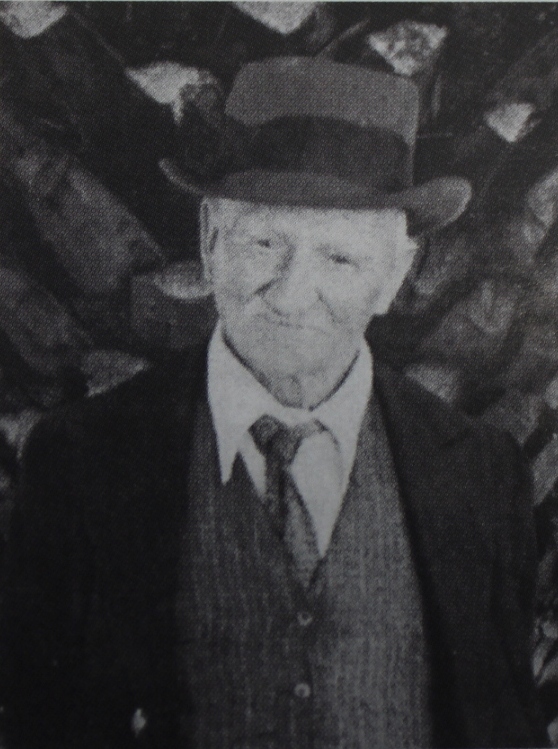 James Booth, the son of a Camden mason Aaron and his wife Eliza, was a carpenter and stonemason by trade himself. He left a lasting legacy of wonderful buildings from Manly to Palm Beach.
James Booth, the son of a Camden mason Aaron and his wife Eliza, was a carpenter and stonemason by trade himself. He left a lasting legacy of wonderful buildings from Manly to Palm Beach. 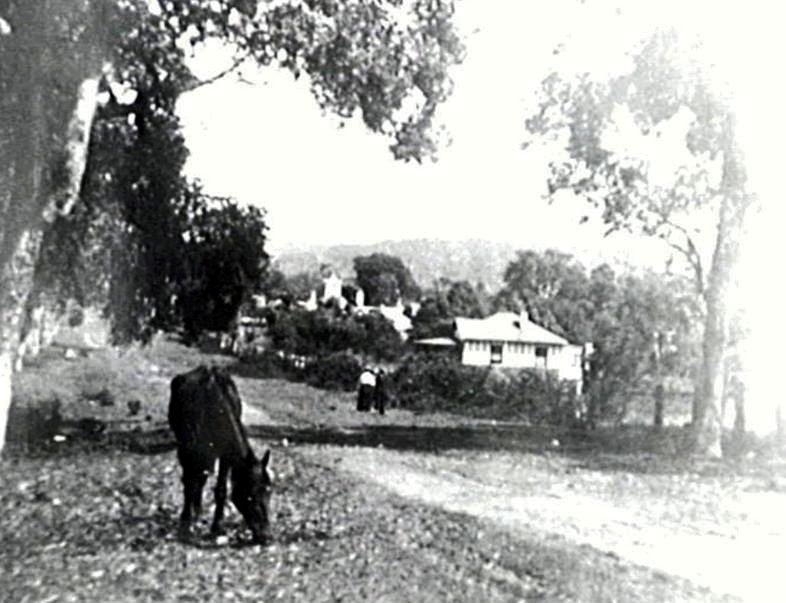
Justine Leontine Briquet, Nee Houreux
Victoria's Public Records Office - Shipping Lists, records among unassisted (paid for themselves) passengers:
HOUREUX L MISS 21 (age) AUG 1900 VILLE DE LA CIOTAT
Justine Leontine, sometimes named as Leontine Justine, was born in Paris. Her gravestone in Mona Vale Cemetery lists her date of birth as April 19th, 1873 meaning she was either 9 when her father came to Australia and 27 when she arrived in August of 1900.
Born in 1860, Auguste Briquet, described as an 'electrician of Mona Vale' , won the lady's heart and they were married, around the time Leon appears to be getting quite ill - MARRIAGES BRIQUET-HOUREUX-May 28, 1906, at Sydney, by the Rev E Tremayne Dunstan, Auguste Briquet, to Leontine Houreux, daughter of Leon Houreux, of Rock Lily Hotel Pittwater. Family Notices. (1906, May 30). The Sydney Morning Herald (NSW : 1842 - 1954), p. 8. Retrieved from http://nla.gov.au/nla.news-article14775685
Marie, listed as Leon's wife when he came to Australia, is heard about no more soon after his arrival. When Leon passes away, soon after her departure to Narrabeen permanently, and soon his daughter's arrival, a twinge of a lament appears years later as inserted by Charlotte Boutin, of the Narrabeen Hotel, and expresses regret -
HOUREUX-In memory of Leon Houreux, late Rock-lily, died April 26, 1907. Regret from his old friend, C. Boutin. Family Notices. (1910, April 26). The Sydney Morning Herald (NSW : 1842 - 1954), p. 6. Retrieved from http://nla.gov.au/nla.news-article15136801
An advertisement announcing Leon's plan also gives an insight into the extent the business had been built up by this stage:
THE ROCK LILY HOTEL, NARRABEEN VIA MANLY - BY ORDER OF THE OWNER AND PROPRIETOR - MONS LEON HOUREUX, WHO IS RETIRING FROM BUSINESS. THIS POPULAR AND WELL - KNOWN HOTEL, together with the furniture and Effects for sale in one line as a going concern. A FREE HOUSE NO LEASE NO BONUS.
THE ROCK LILY HOTEL FRONTS THE PITTWATER ROAD and is situate in a most delightful position within pleasant driving distance of Manly. Mons Houreux has made the place popular and exceedingly attractive especially during the summer season and it is now a well known and much frequented resort doing a profitable and increasing business.
THE HOTEL contains 10 Bedrooms, Large Bar, 3 Dining rooms, 4 sitting- rooms kitchen 2 storerooms, large verandah capable of sitting 120 guests, commodious stabling accommodation also a Cottage of 4 rooms etc.
THE GROUNDS surrounding the Hotel comprise an area of 4ac l rd. 25per and are laid out in orchard and vegetable garden flower garden vine-yard etc The whole most artistically arranged including several aviaries. Immediately opposite the Hotel are
RECREATION GROUNDS of 1 ACRE In extent fitted up for pleasure and Pastime
HARDIE and GORAIAN have received instructions to sell by public auction at their Rooms 133 Pitt street at 11.30 a m on WEDNESDAY JANUARY 20th 1904, The above well known Hotel Property. INVENTORY of Furniture etc on view at the Rooms of the Auctioners from whom cards to inspect the hotel can be obtained. NARRABEEN is a POPULAR WATERSIDE RESORT only a short d stance from Manly by vehiele and partly by tram The VIEWS of the OCEAN and country. Round are splendid and the facilities for BOATING, FISHING and SEA BATHING are very delightful. Advertising. (1904, January 2). The Sydney Morning Herald(NSW : 1842 - 1954), p. 15. Retrieved from http://nla.gov.au/nla.news-article14590362
The Rock Lily did not sell. Leon passed away, apparently in debt as Leontine had to apply to have his debts wiped after his passing. He was buried in the Roman Catholic section of Manly cemetery: 5520/1907 HOUREUX LEON Father: THEODORE Mother: ARMLEEMAI MANLY
DEATH OF M. LEON HOUREUX. The death is announced of M. Leon Houreux, at the Rock Lily Hotel, a few miles from Manly, at the age of 63. He had been ill for some time. M. Houreux was an identity of the district, he perhaps was best known in connection with the coaches that ... ran from Manly to Newport and district and carried the mail. M. Houreux was always conspicuous by His dress when on the box seat of a coach, and in charge of his well Known team of horses. Sydneyites who have visited the Rock Lily Hotel and have seen the paintings on the walls and passageways of the hostelry will agree that he had claims to an originality in his picture's of city men and scenes. DEATH OF M.LEON HOUREUX. (1907, April 27). Evening News(Sydney, NSW : 1869 - 1931), p. 6. Retrieved from http://nla.gov.au/nla.news-article115228077
Art – Glorious Art - The Muralist
Famous Australian artists, the Lindsays, brothers Norman and the photographer here, possibly his brother Norman, to whom these images are credited – visited the Rock Lily when it was under the auspices of Leon’s daughter Justine Leontine and her husband Auguste and here we get to see the murals Leon painted behind them – indicating they attracted other artists or that the place itself was worth visiting – green fields, nearby restorative salt airs and sea waters - and also the age old conundrum of 'everyone's a critic' which so many creative people experience, although others expressed a distinct liking for his murals.
The late M. Leon Heureux, of the Rock Lily Hotel, near Manly, prided himself upon his pictures, with which he adorned the walls of his hotel. He scorned frames, and worked his ideas on the walls. The designs were grotesque, and reminded the visitor of a schoolboy's efforts to draw a square cow or the primitive attempts of Japanese art. Yet poor Heureux was quite proud of them. The pronunciation of his name was often a difficulty to the visitor, but M. Heureux impressed it on the memory by crying out 'Hip, hip, hurro.' The hurro he reckoned would about do. PERSONAL. (1907, May 2). Freeman's Journal (Sydney, NSW : 1850 - 1932), p. 22. Retrieved from http://nla.gov.au/nla.news-article111278123
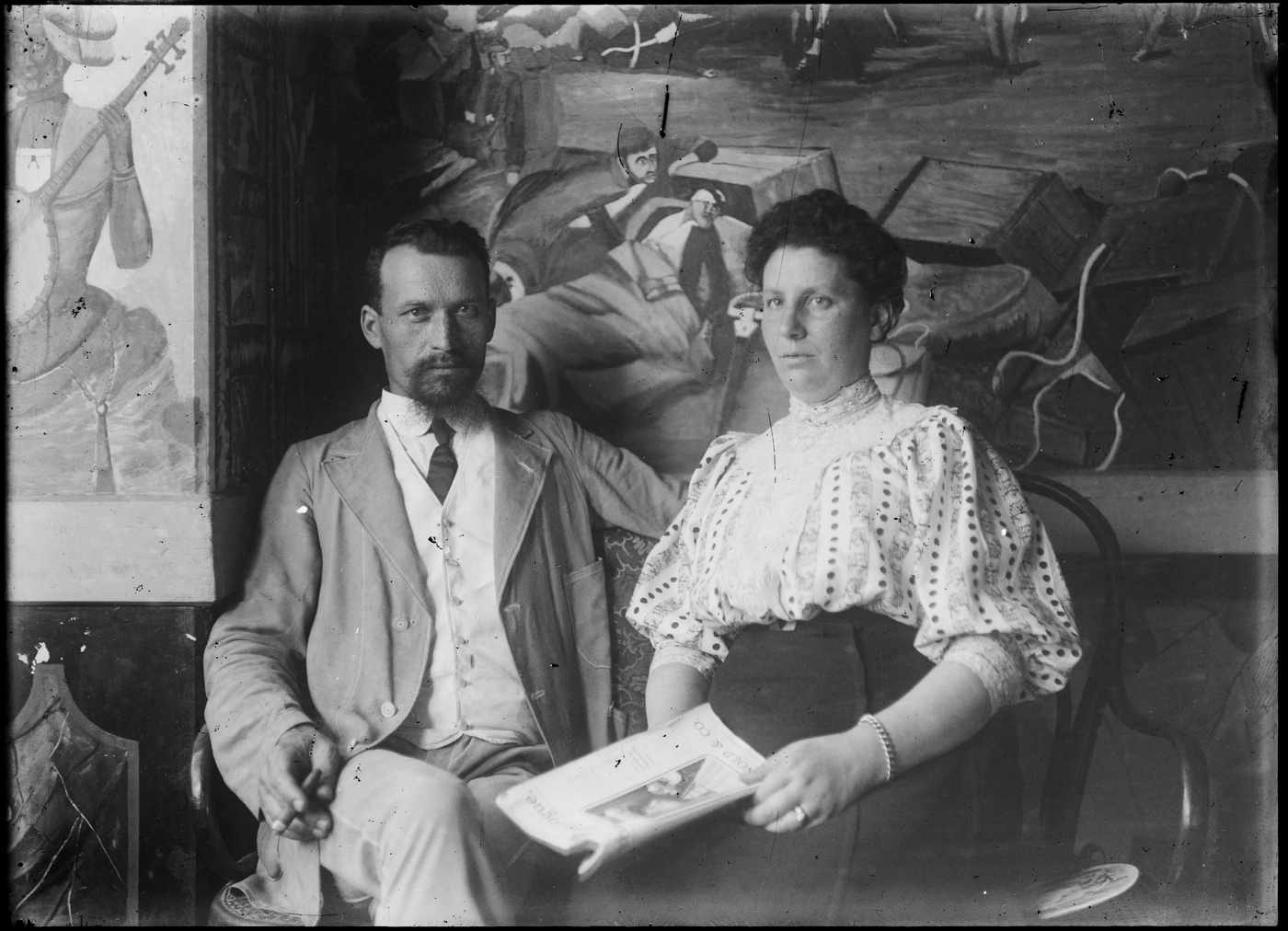
Justine Leontine and her husband Auguste Briquet From State Library of NSW Album: Portraits of Norman and Lionel Lindsay, family and friends, ca. 1900-1912 / photographed chiefly by Lionel Lindsay. Image No.: a2005209h and below: a2005210h
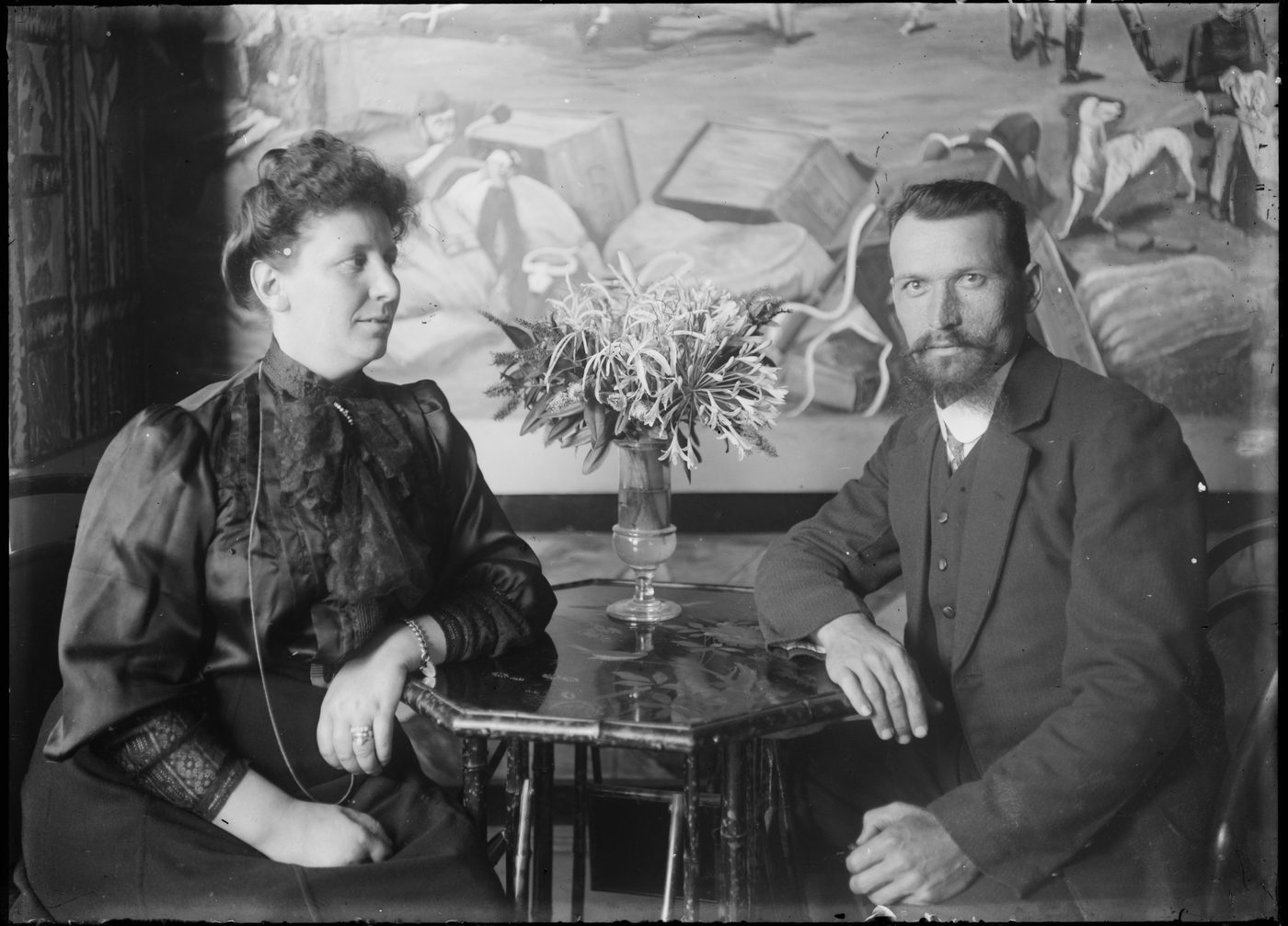
Justine Leontine and Auguste Briquet - 1907. One of Leon's murals on the wall behind them.
After Leon passed away
As so often happens with establishments of this kind, it is the character and passion as much as energy of the person behind it, the originator, and their nature and openness which causes a place to succeed. Great food is required, but a great host is even more vital – not many of us return to, or rave about places we receive snooty or bad service in.
Leontine Justine, in photographs showing her, looks to have a retiring demeanour. Her husband, an electrician by trade, and whom the licence was transferred to, may not have had the same verbosity and zest for life that burned so brightly in Leon Houreaux. Or perhaps the Briquets simply wanted to return to France, or retire to the other family property at Newport, once it was finished.
Either way, after just a few years of running the Rock Lily, and seemingly saddled with mounting debts, the Briquets began attempting to sell off assets in land and structure forms and others were allowed to run what was once the most popular roadhouse in Pittwater. The advertisements for these assets indicate the extent of all Leon had accumulated.
The licence was transferred from his daughter, who inherited his wealth, and debts, to her husband:
Rocklily Hotel, Rock Lily, Manly, from Leontine J. Briquet -adminstratix of Houreux Leon, to Auguste Briquet; HOTELS CHANGE HANDS. (1907, September 28). Evening News (Sydney, NSW : 1869 - 1931), p. 5. Retrieved from http://nla.gov.au/nla.news-article112641966
PITTWATER, NEAR MANLY., RAPIDLY COMING TO THE FRONT AS A FAVOURITE HOLIDAY RESORT. 1. THE ROCKLILY HOTEL, A WELL-KNWON HOLIDAY HOUSE, standing In its own grounds, having frontage of 170 feet to the PITTWATER-ROAD, and 205 feet to VINEYARD STREET, also the Recreation Reserve opposite, having 112 feet frontage to the PITTWATER-ROAD, with an average depth of 276 feet, situated close to the junction of BAY VIEW and NEWPORT ROADS. The House Is built of brick, on brick foundation, with verandah In front, and wide verandah and grape trellis at side, and containing hall, bar, 2 dining rooms, 4 private dining rooms, sitting room, parlour, servants' dining room, 5 bedrooms, servants' bedrooms, store room, 2 lavatories, kitchen, wash- house, cellar in basement, detached bathroom.
IMMEDIATE POSSESSION. The LICENSE and GOODWILL go with the Property. THE TRAFFIC to and from Pittwater at WEEK ENDS and during the HOLIDAY SEASON is very CONSIDERABLE, and as the drive from Manly is comfortably- undertaken by MOTOR OMNIBUS or by UP TO DATE COACHES, MANY VISITORS are ATTRACTED to the DISTRICT. As a SEASIDE RESORT in the hands of an ENERGETIC MAN the ROCKLILY HOTEL might be made one of the FIRST SEASIDE HOUSES north of Sydney.
2. EXTENSIVE COACHING STABLES, occupied by Messrs. Cooper and Co., Coach Proprietors. They comprise stable (24 stalls), coach Houses, workshops, blacksmith' forge, shelter sheds, feed rooms, etc. . THE LAND about on to the hotel site, and has 324 feet frontage to VINEYARD-STREET, with a depth of 160 feet
3 NEWPORT. A WATERSIDE PROPERTY, comprising Lots 4 to 7, Section E, Newport Township, having 264 feet frontage toBEACONSFIELD-STREET, with a depth of over 200 feet, extending to the WATERS of PITTWATER, together with the weatherboardCOTTAGE and UNFINISHED STONE RESIDENCE thereon. By Order of the Executrix of the late LEON HOUREAUX.
RICHARDSON and WRENCH, Ltd., will sell by auction at the Rooms, Pitt-street, on FRIDAY, 27th SEPTEMBER, at II o'clock, The above attractive properties at PITTWATER. E. TREVOR JONES, 5 Bond-street, is Solicitor to the Estate. Full particulars In future issue. (3289 - BY ORDER OF THE EXECUTORS ESTATE LATE Advertising. (1907, September 7). The Sydney Morning Herald (NSW : 1842 - 1954), p. 25. Retrieved from http://nla.gov.au/nla.news-article14879141
Guy Jennings in his book ‘A History of Newport’ reports this two storey stone house to the left in picture was never finished and became a playground for children. Fence opposite is that of Newport Public School. The unfinished house described above, soon after Mr Houreax's passing and offered for sale, and that in this photograph, seem very alike. Scrutiny of early Land Maps also points to this structure.
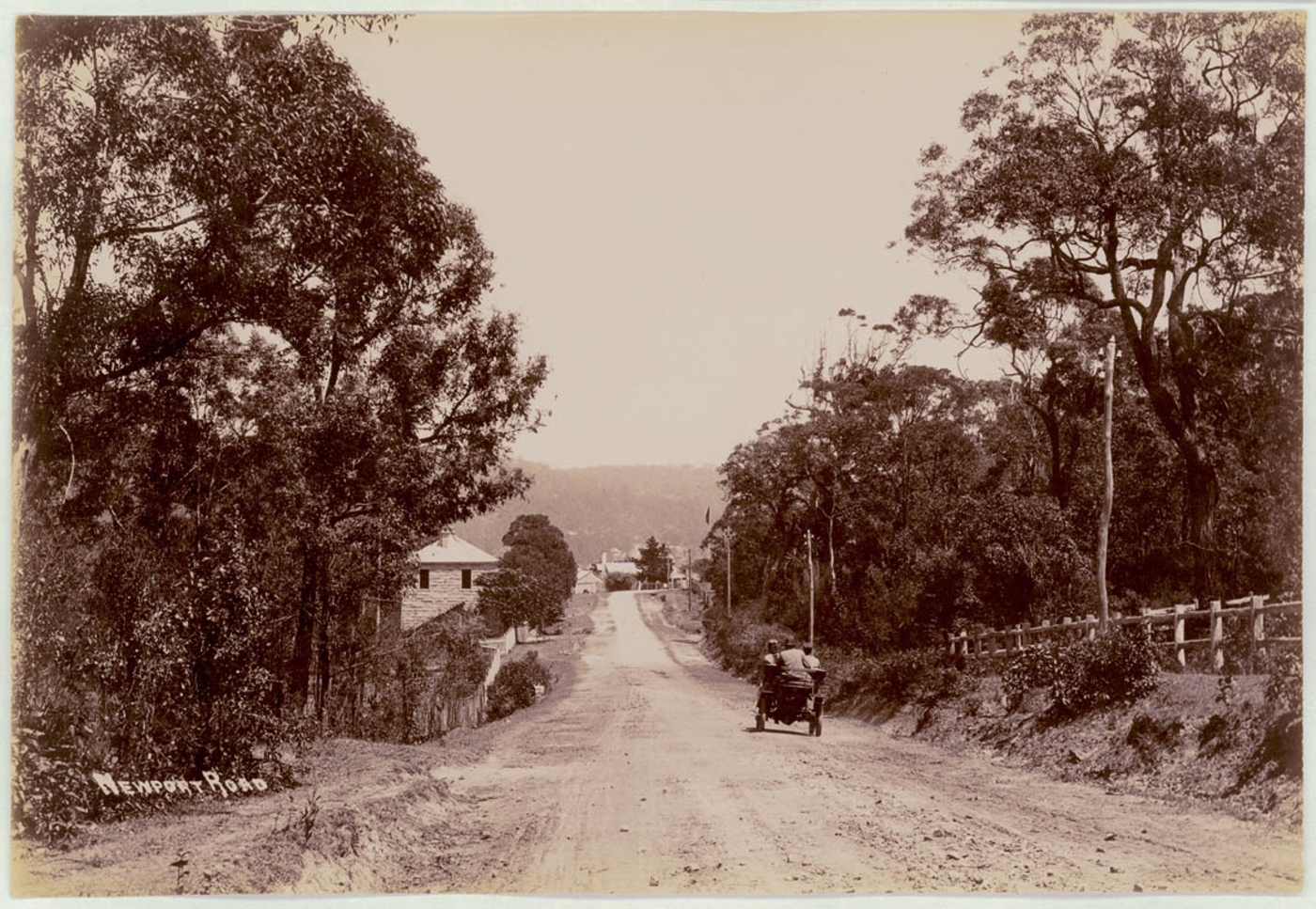
'Newport Road' - ca. 1900-1910, Image No.: a116490h, courtesy State Library of NSW.
Voluntary sequestration is a legal process by which you are declared insolvent by an order of the High Court and your debts are (in layman's terms) written off. The Estate,
VOLUNTARY SEQUESTRATIONS- The estate of Leon Houreux, late of Rocklily, Pittwater, near Manly, hotel-keeper, deceased- on the petition of Leontine Justine Briquet, of Rocklily, Pittwater. Mr. W. H. Palmer, official assignee. LAW REPORT. (1908, January 23). The Sydney Morning Herald (NSW : 1842 - 1954), p. 3. Retrieved from http://nla.gov.au/nla.news-article14939646
Pittwater's lack of a resident population and changes in the Liquor Act spelled the end for the Rock Lily, a consequence that has been echoed over and over, even into present times where the wishes of those who live here are overridden by those who live elsewhere:
ROCKLILY HOTEL
OLD RENDEZVOUS CLOSED.
Where Parkes and Dalley Dined. Frenchman's Famous Paintings.
After nearly thirty years cheerful existence, the old Rocklily Hotel on the Pitt-water-road, near Mona Vale, closed its doors a few days ago against the "sale of alcoholic liquors. The action' of the proprietor (Mr. Briquet) was not voluntary; it was brought about through a decision of the Licensing Court, which selected, the famous tourist rendezvous for slaughter, when the electors of Middle' Harbor voted Reduction three years ago. That reduction in Manly or the Pittwater district was never favored locally has been abundantly proved by the overwhelming majority recorded for Continuance at the recent elections. The thousands of voters in residential Mosman who in 1910 were included In the Middle Harbor electorate, are responsible for the closing of the old Rock-lily Hotel In the tourist territory of Pittwater, the absence of which will leave all the route from Narrabeen to Newport without a licensed house of accommodation. At the elections the other day over 90 per cent of the Pittwater people voted Continuance, and the fact that Mosman residents had the power to legislate for the liquor requirements of a holiday area like Pittwater, demonstrates effectively the many absurd and unfair defects of the Liquor Act.
When Leon Houreaux opened the doors of the hospitable old-fashioned French inn thirty years back, he brought with him from France a first-class knowledge of the cookery of his country, and a fine discrimination regarding the vintage of the grape. Soon the Rocklily Hotel acquired a high reputation amongst tourists for its excellent French dinners, and the superior quality of Its wines. But, besides the reputation reached on account of its attractive cuisine, and cosy comfortableness, the hotel was gradually becoming famous in another direction. Leon Houreaux, who in his days of childhood in France never had a lesson in painting, but who, according to his own words to his daughter, received many thrashings from his parents for disfiguring the neighboring rocks and. fences with colored pictures of man and beast, conceived the idea of decorating the walls of his hostelry with the efforts of his prentice paint brush. Before long, people used to come specially to see the quaint wall paintings, and as he assiduously added picture after picture, the Rocklily Art Gallery became a regular resort of tourists, and brought the painter-proprietor much custom, When Houreaux died several years ago, he had filled every foot of space on the walls, windows, and doors, with his odd oil paintings, representing all kinds of things from battlefields to funny French tit-bits.
Yesterday, as Madame Briquet, daughter of the late painter proprietor, was removing the family belongings from the old rooms, a "Sun" representative was courteously shown the whole life work of the imaginative old Frenchman. As you enter the hall, the first thing to greet you Is a life-size picture of ex-Licensing Inspector Lenthall, the lucky N.S.W. retired police officer who a few years ago came in for an immense fortune in the old country, and died on his English estate. The Rocklily Hotel was a favorite resort of the licensing inspector. Alongside Inspector Lenthall is a big picture of a Bacchanalian individual, evidently wishing the officer a merry Christmas.
In the first of the large rooms one wall is completely filled with a brilliantly-colored representation of the 'battle of "Rorke's Drift." Another wall depicts the death of Nelson at Trafalgar, while a third shows a stirring battle scene, "Vive L'Empereur." The fourth wall is delightfully ; Incongruous, devoted as it is to humorous French subjects. In another room the captive Napoleon on board the Bellerophon glares gloomily down at the deck, while on the opposite wall his great rival, Wellington, Is shown riding up to a battlefield camp; and, judging from the cook's operations, to dinner!
Vividly-hued pictures of French culrasseurs and English lancers in action adorn the remaining walls. There are large pictures in., other rooms of naval reviews, wrecks by the dozen, battles, old-time knights of the road, Australian bush scenes, and pastorals of his own loved native land, all gloriously mixed up with humorous little sketches of the French school. The faces of Generals Hutton and Baden Powell are the most modern additions to the gallery.
The imagination of the energetic old painter was thoroughly cosmopolitan; he dragged every country and every phase of life Into his productions, which though perhaps not works of art, are very interesting, and are remarkable for their bold coloring. Houreaux was undoubtedly a master of color!
The old landlord's faith in the future of Pittwater is shown in a picture on the verandah walls. Houreaux was, by-the-way, a valuable pioneer of the district, and ran the coaches from Manly for many years. The painting shows a steam tram passing the doors of the Rocklily Hotel, while a bustled nigger cyclist capsizes In front of the engine. It was painted 28 years ago, and It looks prophetic. The electric tram now comes to within a few miles of the spot, and will assuredly pass the doors of the old building within a very short period, according to Mr. Griffith's promise.
Old-time frequenters of the hostelry will be pleased to hear that the famous pictures will be preserved. Mr. Briquet, son-in-law of the dead painter, who owns the property, states that he and his wife will keep the place Intact at all costs.
"It has so many -memories for us," says Mr. Briquet. "Ah, It was a great rendezvous for four great men In the old days," Mr. Briquet went on in his quaint French accent; "Mr. Dalley always dined here on Sundays. He was a grand man. Sir Henry Parkes and the other great members of Parliament often visited us, and Sir George Reid— he was here hundreds of times. How did he like a good dinner! It was a pleasure to see him dine! All the artists and great men used to come and enjoy our dinners, and sit sipping their wine under the old grapevines. The great Phil May loved the place. He lived here for nearly a year. He was the great man, and made such fun. And your brilliant young artists the Lindsays stayed here, too. Everybody from all parts of the world used to come here for our dinners, and to see the paintings on the walls!"
One can easily Imagine Sir George Reid, after a delectable French dinner, seated under the spreading, vines, and lazily reaching up now and then for a bunch of luscious grapes. The grapes at present are nearly ripe, and hang In huge clusters, but there will be no hotel patrons to enjoy them. Thanks to the blundering of the Liquor Act, the career of the old hostelry, with its quaint picture gallery,' has been closed, and the road to Pittwater has lost one of its time-honored and cherished attractions.
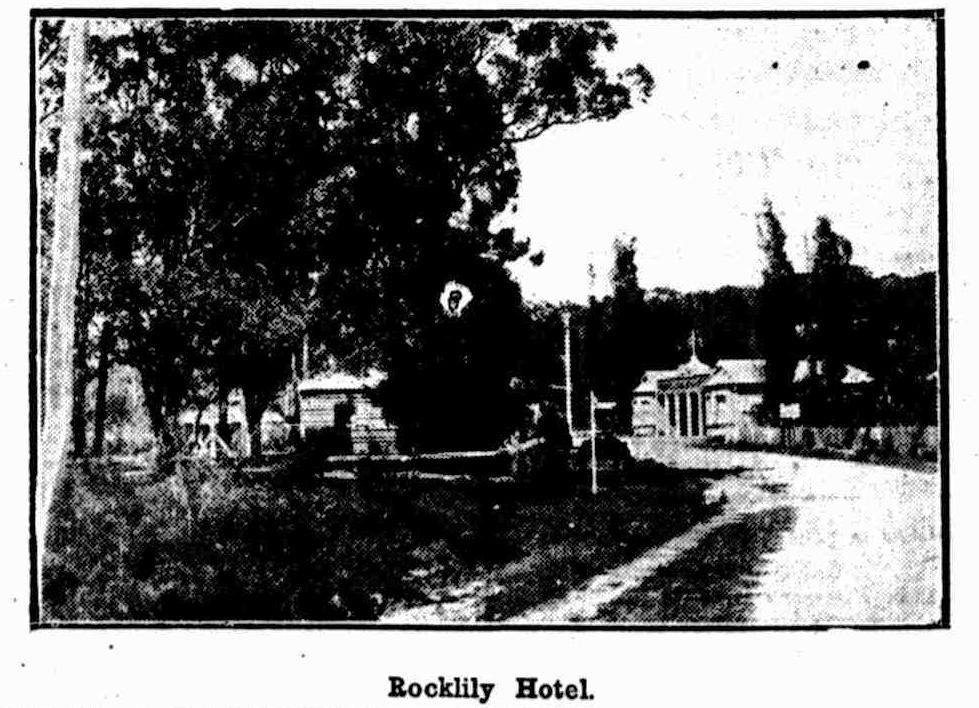
Rocklily Hotel.
ROCKLILY HOTEL. (1914, February 2).The Sun (Sydney, NSW : 1910 - 1954), p. 10. Retrieved from http://nla.gov.au/nla.news-article221559251
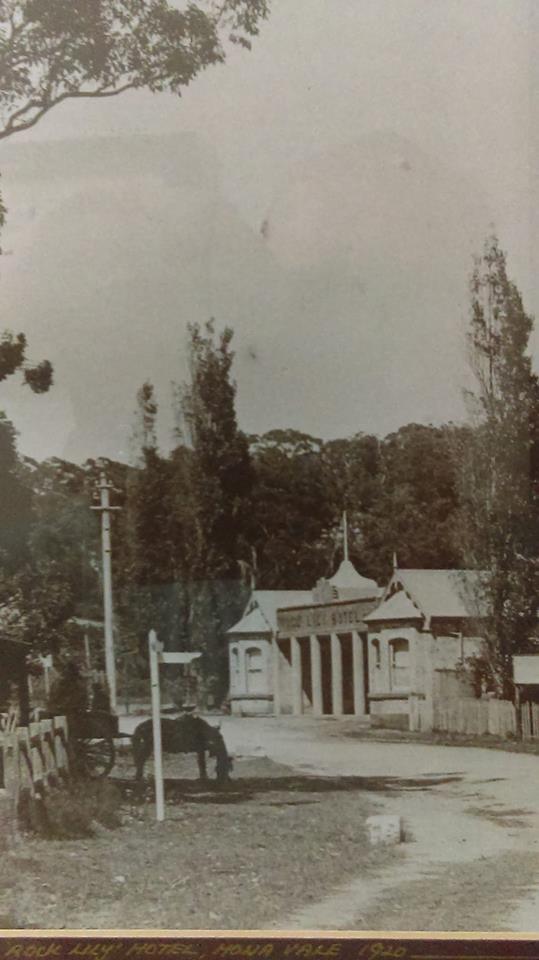
A little from a writer who claims to have actually met this couple, despite the numerous discrepancies in this work:
MODERN ROADHOUSE LINKED BYGONE AGE. SHADES OF THE PAST AND THE NAUGHTY NINETIES.
(BY W. E. M. ABBOTT)
.... With such graceful and musical names, one would feel that the Rock Lily would have continued 'its gay, glittering way, but such was not the case. The flame was already dimmed, and gradually it flickered and was extinguished. Perhaps Justine, and her husband, Monsieur Briquiet, had not the same flair for knowing what the pleasure questing public wanted; perhaps they had not the same gay, insouicance of their less conventional predecessors. Perhaps a new era was already dawning which was to see the passing of the florid, music hall, beer-drinking and spacious era of Edward the Peacemaker. For a little while the Briquets kept the hotel on, then leased it to other licensees until 1913, when it finally closed its doors on the public, and remained merely a home for this couple and for the ghosts of a fashionable past.
As a young boy, the writer, holidaying at Mona Vale, I never counted it complete without a visit to the Rock Lily, and the two Briquets, who gave permission to wander at will through the dusty corridors, where paintings pressed in on one, as though warning not to try and peer into the past and the life they guarded. ' Through stout doors, into high, empty reception rooms, with drawn shades that filtered light on to the perennial frames of Rorke's Drift, or fellsadjy on Napoleon standing on the deck of the Bellerphon, sailing into eternity. More mundane occupation was to visit the great grape trellis and eat one's fill of grapes, and even pick clothes-buckets full to take home for jam-making. Still, among the long grass stood a few neglected, weather-worn tables, waiting in vain for diners long since dead. Monsieur Briquet died some 20 years before his wife, who lived on in this strange hostelry of memories, surrounded by giant charging Grenadiers' and red booted garrison, defenders until her death in 1943.
Then it seemed as if Time stepped in to claim its own, and the dissolution which seemed to have secretly taken possession at the end of Leon Hereux and Madame Bouton's reign, boldly came to the fore, as white-ants, dry rot and the elements, plus the ever-present and also peculiar to Australia, all had their way with the old building. Perhaps after all it is right that the Past belongs to the Past, and that we have no right in our stream-lined modern age, with cocktail parties, and radio, chromium plate and synthetics, sophistication and speed, to peer into a more leisurely and gracious past, which we have discarded for our high-powered present.
Perhaps it is right that Leon has in his withdrawal from an age and a way of living we no longer understand, taken with him 'Madame,' his flourishing hostelry, the gay company that inhabited it, and, lastly, his paintings, leaving only the outline of the building of long ago, and the name, taken from the days when Rock Lilies flourished all about the terrain they were to make famous for two or three decades. MODERN ROADHOUSE LINKED BYGONE AGE. (1949, April 8). The Scone Advocate (NSW : 1887 - 1954), p. 2. Retrieved fromhttp://nla.gov.au/nla.news-article162716433
The Briquets actually closed the doors when liquor licences in the area were reduced - records indicate Auguste owned property adjacent to and including the large Borck residence, where he also had a residence he owned "St Helena". Beginning in 1911, and even until 1929, lots from this land were sold - this would indicate they probably didn't need to work or had enough in assets left to live. A search if NSW Records for land ownership:
Primary Application - Justine Leontine Briquet on Bay View Road & Darley and Allen Streets & on Pacific Ocean near Pittwater Shire Warringah Parish Narrabeen Volume 2195 Folios 181 & 182 - 6 acres 1 rood. Date range: 19/10/1910 to 30/10/1911
and:
Primary Application - Justine Leontine Briquet 4 acres 1 rood 21 1/2 perches on Pittwater & Gordon Roads & Vineyard Street near Pittwater in Shire Warringah Parish Narrabeen County Cumberland Volume 2762 Folio 161 Date range: 15/12/1913 to 05/06/1917
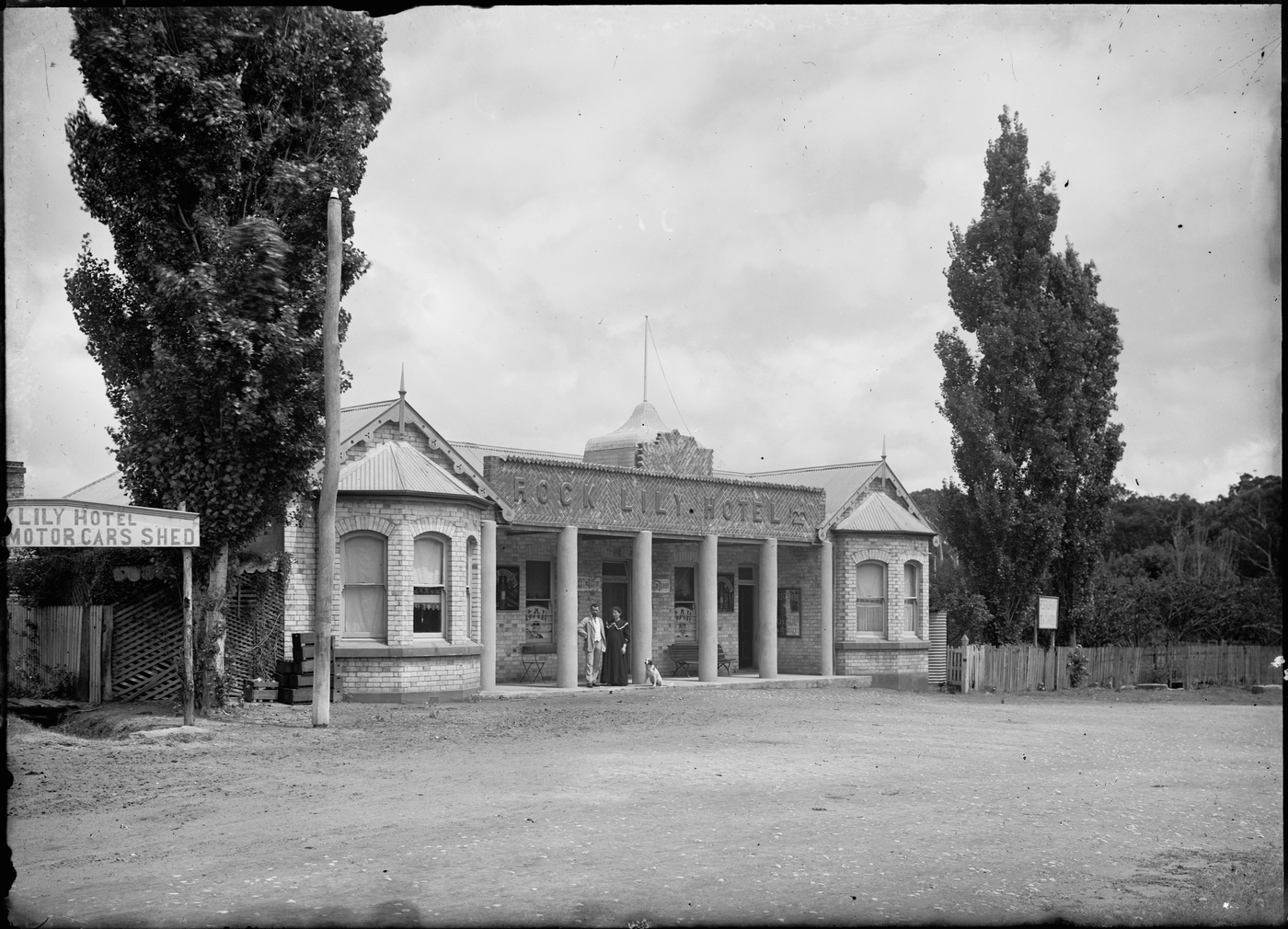
Rock Lily Hotel [Narrabeen] from State Library of NSW Album: Portraits of Norman and Lionel Lindsay, family and friends, ca. 1900-1912 / photographed chiefly by Lionel Lindsay. Image No.: a2005211h - Auguste and Justine Leontine Briquet are on front entranceway. More in Pittwater Restaurants You Could Stay At The Rock Lily Hotel – Mona Vale